Vegetation Changes in the Arctic: A Review of Earth Observation Applications
Abstract
:1. Introduction
1.1. Changes in the Arctic and Sub-Arctic Regions
1.2. Remote Sensing of Vegetation in the Arctic and Sub-Arctic Region
1.3. Objectives of This Review
2. Review Methodology
- Quantitative analysis of meta data, like number of published articles per year and first-author affiliations
- Spatial and temporal coverage of studies
- Utilised sensor and satellite data
- Examined research objectives
- Methods
- Important findings and challenges
3. Results
3.1. Quantitative Analysis of Publication Meta Data
3.2. Spatial and Temporal Coverage
- (a)
- (b)
- (c)
- (d)
3.3. Examined Research Objectives
3.3.1. VI Trends
3.3.2. Species Composition
3.3.3. Plant Phenology
3.3.4. Plant Productivity
3.3.5. Disturbance
3.4. Sensors and Satellites
3.5. Methods
3.6. Circumpolar Trends and Their Drivers
4. Discussion
4.1. Limitations of the Review Design
4.2. Challenges of Monitoring Arctic and Sub-Arctic Vegetation
4.2.1. Availability of Environmental Parameters and In Situ Data
4.2.2. Acquisition of Optical Data
4.2.3. Poor Comparability of Vegetation Index Trends
4.3. Dominance of NDVI
4.4. Geographical Hotspots and Data Availability
4.5. Methodological Development
4.6. Outlook
5. Conclusions
- Spatial and temporal coverage: Most studies were conducted at a local scale (78), while 37 studies encompassed the circumpolar area, including the boreal zone. The majority of articles cover a study area within the sub-Arctic boundary, particularly the North Slope of Alaska and the Canadian Arctic regions. Fewer studies cover the Eurasian continent, with two hotspots in the Scandinavian and Russian Arctic regions. Notably, 75% of the studies used continuous time-series data, primarily from AVHRR (1981/82 onwards) and MODIS (2000 onwards).
- Sensors and satellites: A little over half of all studies were based on data from a single satellite, with multispectral sensor types dominating (∼93%). The most commonly utilised sensors are the AVHRR (NOAA, Aqua-Terra (MODIS) and Landsat satellites. Other sensor types were limited to specific research applications, e.g., using Camera footage from declassified reconnaissance satellites to derive changes of the treeline and shrub cover or thermal and hyperspectral data for vegetation classification. Notably absent are studies utilising Synthetic Aperture Radar (SAR) data. In general, the share of higher-resolution data declines with increasing study area size. All research objective categories, with the exception of phenology studie, are predominately using 10–80 m spatial resolution data. Fine-resolution data are confined to the articles analysing the species composition and VI trends.
- Research objectives: The majority of the 77 research articles that were focused on VI trends used NDVI as the radiometric index. VI trends were derived across all study area sizes. Species composition (35) was the second largest research objective category and conducted mostly on a local scale. Of these, 10 articles specifically addressed treeline changes, while 11 studies investigated the expansion of shrubs. The changes in plant phenology were examined in 17 articles at the local, regional, or circumpolar scales. The “plant productivity” category comprised 17 articles that focused on the estimation of primary productivity based on NPP and GPP, as well as one article that derived plant biomass as a primary objective. The smallest research objective category, with eight articles, focused on understanding the mechanism of disturbances and the subsequent vegetation recovery predominately on a local scale. As the Arctic continues to change, studying the combinations of vegetation, snow cover, and permafrost will become increasingly important. Moreover, it is of the great importance to maintain a unified effort to collect high-quality in situ data.
- Common (circumpolar) trends: most studies found evidence for Arctic greening in at least some parts of their study area (n = 27), or mixed trends with predominately greening (n = 26). Studies focusing on the changes of species composition generally indicate a widespread decline in lichen coverage, often accompanied by an increase in shrubs. In addition, the majority of articles derived positive productivity trends. The development of plant phenology indicates an increase in growing season length, but start and end-of-season dynamics are heterogeneous throughout the circumpolar Arctic. The disturbance and recovery mechanisms in the tundra region are diverse, and the review results did not show uniform trends for either research objective.
- Methods: Following the method categories defined in Section 3.5, we found that most articles applied some form of classic regression and correlation analysis. Machine-learning algorithms were used for classification and regression approaches, and a small increase was found since 2019. Only three articles applied a deep-learning method. Methods belonging to the “phenometrics”, “regression”, and “statistical association” category are roughly equally distributed over time, whereas “change detection” and “classification” methods are more common since 2018. It is anticipated that subsequent studies will benefit from methodological advancements in data fusion and causal analysis.
- Common ecological conditions: Although an increase in temperature has been linked to greening, shrub expansion, and increased plant productivity, the driving forces behind the diverse and localised ecological changes observed in the Arctic and sub-Arctic regions are numerous and complex.
Supplementary Materials
Author Contributions
Funding
Data Availability Statement
Acknowledgments
Conflicts of Interest
References
- Esau, I.; Pettersson, L.H.; Cancet, M.; Chapron, B.; Chernokulsky, A.; Donlon, C.; Sizov, O.; Soromotin, A.; Johannesen, J.A. The Arctic Amplification and Its Impact: A Synthesis through Satellite Observations. Remote Sens. 2023, 15, 1354. [Google Scholar] [CrossRef]
- Rantanen, M.; Karpechko, A.Y.; Lipponen, A.; Nordling, K.; Hyvärinen, O.; Ruosteenoja, K.; Vihma, T.; Laaksonen, A. The Arctic Has Warmed Nearly Four Times Faster than the Globe since 1979. Commun. Earth Environ. 2022, 3, 168. [Google Scholar] [CrossRef]
- Piao, S.; Wang, X.; Park, T.; Chen, C.; Lian, X.; He, Y.; Bjerke, J.W.; Chen, A.; Ciais, P.; Tommervik, H.; et al. Characteristics, Drivers and Feedbacks of Global Greening. Nat. Rev. Earth Environ. 2020, 1, 14–27. [Google Scholar] [CrossRef]
- Taylor, J.J.; Lawler, J.P.; Aronsson, M.; Barry, T.; Bjorkman, A.D.; Christensen, T.; Coulson, S.J.; Cuyler, C.; Ehrich, D.; Falk, K.; et al. Arctic Terrestrial Biodiversity Status and Trends: A Synopsis of Science Supporting the CBMP State of Arctic Terrestrial Biodiversity Report. Ambio 2020, 49, 833–847. [Google Scholar] [CrossRef]
- University of Maryland Center for Environmental Science. IAN Symbol Libraries. Available online: https://ian.umces.edu/symbols/ (accessed on 15 July 2024).
- Freie Universität Berlin—RESEDA. Available online: https://blogs.fu-berlin.de/reseda/sentinel-2/ (accessed on 15 May 2024).
- Meltofte, M. Arctic Biodiversity Assessment: Status and Trends in Arcitc Biodiversity; The Conservation of Arctic Flora and Fauna: Akureyri, Iceland, 2013. [Google Scholar]
- Arctic Definitions Combined. Arctic Portal. Available online: https://arcticportal.org/maps/download/arctic-definitions/2426-arctic-definitions (accessed on 15 May 2024).
- Walker, D.A.; Raynolds, M.K.; Daniëls, F.J.; Einarsson, E.; Elvebakk, A.; Gould, W.A.; Katenin, A.E.; Kholod, S.S.; Markon, C.J.; Melnikov, E.S.; et al. The Circumpolar Arctic Vegetation Map. J. Veg. Sci. 2005, 16, 267–282. [Google Scholar] [CrossRef]
- Beamish, A.; Raynolds, M.K.; Epstein, H.; Frost, V.G.; Macander, M.J.; Bergstedt, H.; Bartsch, A.; Kruse, S.; Miles, V.; Tanis, C.M.; et al. Recent Trends and Remaining Challenges for Optical Remote Sensing of Arctic Tundra Vegetation: A Review and Outlook. Remote Sens. Environ. 2020, 246, 111872. [Google Scholar] [CrossRef]
- Corell, R. Arctic Climate Impact Assessment. Bull. Am. Meteorol. Soc. 2005, 86, 860–861. [Google Scholar]
- PhenoCam—An Ecosystem Phenology Camera Network. Available online: https://phenocam.nau.edu/webcam/network/map/ (accessed on 15 May 2024).
- Global Geo-Referenced Field Photo Library. Available online: https://www.ceom.ou.edu/photos/map/ (accessed on 15 May 2024).
- FLUXNET—The Data Portal Serving the FLUXNET Community. Available online: https://fluxnet.org/about/ (accessed on 15 May 2024).
- Nill, L.; Grunberg, I.; Ullmann, T.; Gessner, M.; Boike, J.; Hostert, P. Arctic Shrub Expansion Revealed by Landsat-derived Multitemporal Vegetation Cover Fractions in the Western Canadian Arctic. Remote Sens. Environ. 2022, 281, 113228. [Google Scholar] [CrossRef]
- Myers-Smith, I.H.; Kerby, J.T.; Phoenix, G.K.; Bjerke, J.W.; Epstein, H.E.; Assmann, J.J.; John, C.; Andreu-Hayles, L.; Angers-Blondin, S.; Beck, P.S.A.; et al. Complexity Revealed in the Greening of the Arctic. Nat. Clim. Chang. 2020, 10, 106–117. [Google Scholar] [CrossRef]
- Callaghan, V.T.; Gatti, R.C.; Phoenix, G. The Need to Understand the Stability of Arctic Vegetation during Rapid Climate Change: An Assessment of Imbalance in the Literature. Ambio 2022, 51, 1034–1044. [Google Scholar] [CrossRef]
- Vickers, H.; Hogda, K.A.; Solbo, S.; Karlsen, S.R.; Tommervik, H.; Aanes, R.; Hansen, B.B. Changes in Greening in the High Arctic: Insights from a 30 Year AVHRR Max NDVI Dataset for Svalbard. Environ. Res. Lett. 2016, 11, 105004. [Google Scholar] [CrossRef]
- Chen, W.; White, L.; Leblanc, S.G.; Latifovic, R.; Olthof, I. Elevation-Dependent Changes to Plant Phenology in Canada’s Arctic Detected Using Long-Term Satellite Observations. Atmosphere 2021, 12, 1133. [Google Scholar] [CrossRef]
- Olthof, I.; Pouliot, D.; Latifovic, R.; Chen, W. Recent (1986–2006) Vegetation-Specific NDVI Trends in Northern Canada from Satellite Data. Arctic 2008, 61, 381–394. [Google Scholar] [CrossRef]
- Magnusson, R.I.; Limpens, J.; Kleijn, D.; van Huissteden, K.; Maximov, T.C.; Lobry, S.; Heijmans, M.M.P.D. Shrub Decline and Expansion of Wetland Vegetation Revealed by Very High Resolution Land Cover Change Detection in the Siberian Lowland Tundra. Sci. Total. Environ. 2021, 782, 146877. [Google Scholar] [CrossRef]
- Li, J.; Holmgren, M.; Xu, C. Greening vs Browning? Surface Water Cover Mediates How Tundra and Boreal Ecosystems Respond to Climate Warming. Environ. Res. Lett. 2021, 16, 104004. [Google Scholar] [CrossRef]
- Potter, C. Regional Analysis of MODIS Satellite Greenness Trends for Ecosystems of Interior Alaska. Gisci. Remote Sens. 2014, 51, 390–402. [Google Scholar] [CrossRef]
- Pastick, N.J.; Jorgenson, M.T.; Goetz, S.J.; Jones, B.M.; Wylie, B.K.; Minsley, B.J.; Genet, H.; Knight, J.F.; Swanson, D.K.; Jorgenson, J.C. Spatiotemporal Remote Sensing of Ecosystem Change and Causation across Alaska. Glob. Chang. Biol. 2019, 25, 1171–1189. [Google Scholar] [CrossRef]
- Raynolds, M.K.; Walker, D.A.; Verbyla, D.; Munger, C.A. Patterns of Change within a Tundra Landscape: 22-Year Landsat NDVI Trends in an Area of the Northern Foothills of the Brooks Range, Alaska. Arct. Antarct. Alp. Res. 2013, 45, 249–260. [Google Scholar] [CrossRef]
- Bokhorst, S.; Tommervik, H.; Callaghan, T.V.; Phoenix, G.K.; Bjerke, J.W. Vegetation Recovery Following Extreme Winter Warming Events in the Sub-Arctic Estimated Using NDVI from Remote Sensing and Handheld Passive Proximal Sensors. Environ. Exp. Bot. 2012, 81, 18–25. [Google Scholar] [CrossRef]
- Magnusson, R.I.; Groten, F.; Bartholomeus, H.; van Huissteden, K.; Heijmans, M.M.P.D. Tundra Browning in the Indigirka Lowlands (North-Eastern Siberia) Explained by Drought, Floods and Small-Scale Vegetation Shifts. J. Geophys. Res.-Biogeosci. 2023, 128, e2022JG007330. [Google Scholar] [CrossRef]
- Stow, D.A.; Hope, A.; McGuire, D.; Verbyla, D.; Gamon, J.; Huemmrich, F.; Houston, S.; Racine, C.; Sturm, M.; Tape, K.; et al. Remote Sensing of Vegetation and Land-Cover Change in Arctic Tundra Ecosystems. Remote Sens. Environ. 2004, 89, 281–308. [Google Scholar] [CrossRef]
- Walker, D.A.; Leibman, M.O.; Epstein, H.E.; Forbes, B.C.; Bhatt, U.S.; Raynolds, M.K.; Comiso, J.C.; Gubarkov, A.A.; Khomutov, A.V.; Jia, G.J.; et al. Spatial and Temporal Patterns of Greenness on the Yamal Peninsula, Russia: Interactions of Ecological and Social Factors Affecting the Arctic Normalized Difference Vegetation Index. Environ. Res. Lett. 2009, 4, 045004. [Google Scholar] [CrossRef]
- Tommervik, H.; Johansen, B.; Riseth, J.A.; Karlsen, S.R.; Solberg, B.; Hogda, K.A. Above Ground Biomass Changes in the Mountain Birch Forests and Mountain Heaths of Finnmarksvidda, Northern Norway, in the Period 1957–2006. For. Ecol. Manag. 2009, 257, 244–257. [Google Scholar] [CrossRef]
- Jorgenson, M.T.; Grosse, G. Remote Sensing of Landscape Change in Permafrost Regions. Permafr. Periglac. Process. 2016, 27, 324–338. [Google Scholar] [CrossRef]
- Callaghan, T.V.; Tweedie, C.E.; Akerman, J.; Andrews, C.; Bergstedt, J.; Butler, M.G.; Christensen, T.R.; Cooley, D.; Dahlberg, U.; Danby, R.K.; et al. Multi-Decadal Changes in Tundra Environments and Ecosystems: Synthesis of the International Polar Year-Back to the Future Project (IPY-BTF). Ambio 2011, 40, 705–716. [Google Scholar] [CrossRef]
- Foster, A.C.; Wang, J.A.; Frost, V.G.; Davidson, S.J.; Hoy, E.; Turner, K.W.; Sonnentag, O.; Epstein, H.; Berner, L.T.; Armstrong, A.H.; et al. Disturbances in North American Boreal Forest and Arctic Tundra: Impacts, Interactions, and Responses. Environ. Res. Lett. 2022, 17, 113001. [Google Scholar] [CrossRef]
- Page, M.J.; McKenzie, J.E.; Bossuyt, P.M.; Boutron, I.; Hoffmann, T.C.; Mulrow, C.D.; Shamseer, L.; Tetzlaff, J.M.; Akl, E.A.; Brennan, S.E.; et al. The PRISMA 2020 statement: An updated guideline for reporting systematic reviews. Syst. Rev. 2021, 10, 89. [Google Scholar] [CrossRef]
- WMO Guidelines on the Calculation of Climate Normals (WMO-No. 1203). Available online: https://library.wmo.int/viewer/55797?medianame=1203_en_#page=1&viewer=picture&o=search&n=0&q=30 (accessed on 5 August 2024).
- CAFF Arctic Boundary. Available online: https://map.arcticportal.org/cesium-dev/ (accessed on 15 May 2024).
- Fensholt, R.; Proud, S.R. Evaluation of Earth Observation Based Global Long Term Vegetation Trends—Comparing GIMMS and MODIS Global NDVI Time Series. Remote Sens. Environ. 2012, 119, 131–147. [Google Scholar] [CrossRef]
- Chen, X.; Yang, Y.; Du, J. Distribution and Attribution of Earlier Start of the Growing Season over the Northern Hemisphere from 2001–2018. Remote Sens. 2022, 14, 2964. [Google Scholar] [CrossRef]
- Liu, H.; Gong, P.; Wang, J.; Clinton, N.; Bai, Y.; Liang, S. Annual Dynamics of Global Land Cover and Its Long-Term Changes from 1982 to 2015. Earth Syst. Sci. Data 2020, 12, 1217–1243. [Google Scholar] [CrossRef]
- Kimball, J.S.; Zhao, M.; McGuire, A.D.; Heinsch, F.A.; Clein, J.; Calef, M.; Jolly, W.M.; Kang, S.; Euskirchen, S.E.; McDonald, K.C.; et al. Recent Climate-Driven Increases in Vegetation Productivity for the Western Arctic: Evidence of an Acceleration of the Northern Terrestrial Carbon Cycle. Earth Interact. 2007, 11, 1–30. [Google Scholar] [CrossRef]
- Kimball, J.S.; McDonald, K.C.; Zhao, M. Terrestrial Vegetation Productivity in the Western Arctic Observed from Satellite Microwave and Optical Remote Sensing. Earth Interact. 2006, 10, 1–22. [Google Scholar]
- Kennedy, B.; Pouliot, D.; Manseau, M.; Fraser, R.; Duffe, J.; Pasher, J.; Chen, W.; Olthof, I. Assessment of Landsat-based Terricolous Macrolichen Cover Retrieval and Change Analysis over Caribou Ranges in Northern Canada and Alaska. Remote Sens. Environ. 2020, 240, 111694. [Google Scholar] [CrossRef]
- Macander, M.J.; Nelson, P.R.; Nawrocki, T.W.; Frost, V.G.; Orndahl, K.M.; Palm, E.C.; Wells, A.F.; Goetz, S.J. Time-Series Maps Reveal Widespread Change in Plant Functional Type Cover across Arctic and Boreal Alaska and Yukon. Environ. Res. Lett. 2022, 17, 054042. [Google Scholar] [CrossRef]
- Welch, A.M.; Pedron, S.A.; Jespersen, R.G.; Xu, X.; Martinez, B.; Khazindar, Y.; Fiore, N.M.; Goulden, M.L.; Czimczik, C.I. Implications of Alder Shrub Growth for Alpine Tundra Soil Properties in Interior Alaska. Arct. Antarct. Alp. Res. 2023, 55. [Google Scholar] [CrossRef]
- Andreu-Hayles, L.; Gaglioti, V.B.; Berner, L.T.; Levesque, M.; Anchukaitis, K.J.; Goetz, S.J.; D’Arrigo, R. A Narrow Window of Summer Temperatures Associated with Shrub Growth in Arctic Alaska. Environ. Res. Lett. 2020, 15, 105012. [Google Scholar] [CrossRef]
- Potter, C.; Alexander, O. Changes in Vegetation Phenology and Productivity in Alaska over the Past Two Decades. Remote Sens. 2020, 12, 1546. [Google Scholar] [CrossRef]
- Liu, Y.; Riley, W.J.; Keenan, T.F.; Mekonnen, Z.A.; Holm, J.A.; Zhu, Q.; Torn, M.S. Dispersal and Fire Limit Arctic Shrub Expansion. Nat. Commun. 2022, 13, 3843. [Google Scholar] [CrossRef]
- Stow, D.; Petersen, A.; Hope, A.; Engstrom, R.; Coulter, L. Greenness Trends of Arctic Tundra Vegetation in the 1990s: Comparison of Two NDVI Data Sets from NOAA AVHRR Systems. Int. J. Remote Sens. 2007, 28, 4807–4822. [Google Scholar] [CrossRef]
- Jia, G.J.; Epstein, H.E.; Walker, D.A. Controls over Intra-Seasonal Dynamics of AVHRR NDVI for the Arctic Tundra in Northern Alaska. Int. J. Remote Sens. 2004, 25, 1547–1564. [Google Scholar] [CrossRef]
- Jia, G.S.J.; Epstein, H.E.; Walker, D.A. Greening of Arctic Alaska, 1981–2001. Geophys. Res. Lett. 2003, 30, 1–4. [Google Scholar] [CrossRef]
- Duchesne, R.R.; Chopping, M.J.; Tape, K.D.; Wang, Z.; Schaaf, C.L.B. Changes in Tall Shrub Abundance on the North Slope of Alaska, 2000–2010. Remote Sens. Environ. 2018, 219, 221–232. [Google Scholar] [CrossRef]
- Beck, P.S.A.; Juday, G.P.; Alix, C.; Barber, V.A.; Winslow, S.E.; Sousa, E.E.; Heiser, P.; Herriges, J.D.; Goetz, S.J. Changes in Forest Productivity across Alaska Consistent with Biome Shift. Ecol. Lett. 2011, 14, 373–379. [Google Scholar] [CrossRef] [PubMed]
- Klaar, M.J.; Kidd, C.; Malone, E.; Bartlett, R.; Pinay, G.; Chapin, F.S.; Milner, A. Vegetation Succession in Deglaciated Landscapes: Implications for Sediment and Landscape Stability. Earth Surf. Process. Landf. 2015, 40, 1088–1100. [Google Scholar] [CrossRef]
- Stueve, K.M.; Isaacs, R.E.; Tyrrell, L.E.; Densmore, R.V. Spatial Variability of Biotic and Abiotic Tree Establishment Constraints across a Treeline Ecotone in the Alaska Range. Ecology 2011, 92, 496–506. [Google Scholar] [CrossRef]
- Ju, J.; Masek, J.G. The Vegetation Greenness Trend in Canada and US Alaska from 1984–2012 Landsat Data. Remote Sens. Environ. 2016, 176, 1–16. [Google Scholar] [CrossRef]
- Rocha, A.V.; Blakely, B.; Jiang, Y.; Wright, K.S.; Curasi, S.R. Is Arctic Greening Consistent with the Ecology of Tundra? Lessons from an Ecologically Informed Mass Balance Model. Environ. Res. Lett. 2018, 13, 125007. [Google Scholar] [CrossRef]
- Schore, A.I.G.; Fraterrigo, J.M.; Salmon, V.G.; Yang, D.; Lara, M.J. Nitrogen Fixing Shrubs Advance the Pace of Tall-Shrub Expansion in Low-Arctic Tundra. Commun. Earth Environ. 2023, 4, 421. [Google Scholar] [CrossRef]
- Stow, D.; Daeschner, S.; Hope, A.; Douglas, D.; Petersen, A.; Myneni, R.; Zhou, L.; Oechel, W. Variability of the Seasonally Integrated Normalized Difference Vegetation Index across the North Slope of Alaska in the 1990s. Int. J. Remote Sens. 2003, 24, 1111–1117. [Google Scholar] [CrossRef]
- Verbyla, D. The Greening and Browning of Alaska Based on 1982–2003 Satellite Data. Glob. Ecol. Biogeogr. 2008, 17, 547–555. [Google Scholar] [CrossRef]
- Bieniek, P.A.; Bhatt, U.S.; Walker, D.A.; Raynolds, M.K.; Comiso, J.C.; Epstein, H.E.; Pinzon, J.E.; Tucker, C.J.; Thoman, R.L.; Tran, H.; et al. Climate Drivers Linked to Changing Seasonality of Alaska Coastal Tundra Vegetation Productivity. Earth Interact. 2015, 19, 1–29. [Google Scholar] [CrossRef]
- Walker, D.A.; Epstein, H.E.; Jia, G.J.; Balser, A.; Copass, C.; Edwards, E.J.; Gould, W.A.; Hollingsworth, J.; Knudson, J.; Maier, H.A.; et al. Phytomass, LAI, and NDVI in Northern Alaska: Relationships to Summer Warmth, Soil pH, Plant Functional Types, and Extrapolation to the Circumpolar Arctic. J. Geophys. Res.-Atmos. 2003, 108, 1–18. [Google Scholar] [CrossRef]
- Masek, J.G. Stability of Boreal Forest Stands during Recent Climate Change: Evidence from Landsat Satellite Imagery. J. Biogeogr. 2001, 28, 967–976. [Google Scholar] [CrossRef]
- Olthof, I.; Pouliot, D. Treeline Vegetation Composition and Change in Canada’s Western Subarctic from AVHRR and Canopy Reflectance Modeling. Remote Sens. Environ. 2010, 114, 805–815. [Google Scholar] [CrossRef]
- Bonta, C.; King, G.M.; Danby, R.K. Greening on the Bathurst Caribou Range in Northern Canada: Are Erect Shrubs Responsible for Remotely Sensed Trends? Arct. Sci. 2023, 9, 581–599. [Google Scholar] [CrossRef]
- Bonney, M.T.; Danby, R.K.; Treitz, P.M. Landscape Variability of Vegetation Change across the Forest to Tundra Transition of Central Canada. Remote Sens. Environ. 2018, 217, 18–29. [Google Scholar] [CrossRef]
- Dearborn, K.D.; Danby, R.K. Remotely Sensed Trends in Vegetation Productivity and Phenology during Population Decline of the Bathurst Caribou (Rangifer tarandus groenlandicus) Herd. Arct. Sci. 2022, 8, 228–251. [Google Scholar] [CrossRef]
- Tommervik, H.; Johansen, B.; Tombre, I.; Thannheiser, D.; Hogda, K.A.; Gaare, E.; Wielgolaski, F.E. Vegetation Changes in the Nordic Mountain Birch Forest: The Influence of Grazing and Climate Change. Arct. Antarct. Alp. Res. 2004, 36, 323–332. [Google Scholar] [CrossRef]
- Hofgaard, A.; Tommervik, H.; Rees, G.; Hanssen, F. Latitudinal Forest Advance in Northernmost Norway since the Early 20th Century. J. Biogeogr. 2013, 40, 938–949. [Google Scholar] [CrossRef]
- Johansen, B.; Karlsen, S.R. Monitoring Vegetation Changes on Finnmarksvidda, Northern Norway, Using Landsat MSS and Landsat TM/ETM plus Satellite Images. Phytocoenologia 2005, 35, 969–984. [Google Scholar] [CrossRef]
- Franke, A.K.; Feilhauer, H.; Braeuning, A.; Rautio, P.; Braun, M. Remotely Sensed Estimation of Vegetation Shifts in the Polar and Alpine Tree Line Ecotone in Finnish Lapland during the Last Three Decades. For. Ecol. Manag. 2019, 454, 117668. [Google Scholar] [CrossRef]
- Auda, Y.; Lundin, E.J.; Gustafsson, J.; Pokrovsky, O.S.; Cazaurang, S.; Orgogozo, L. A New Land Cover Map of Two Watersheds under Long-Term Environmental Monitoring in the Swedish Arctic Using Sentinel-2 Data. Water 2023, 15, 3311. [Google Scholar] [CrossRef]
- Frost, G.V.; Epstein, H.E.; Walker, D.A. Regional and Landscape-Scale Variability of Landsat-observed Vegetation Dynamics in Northwest Siberian Tundra. Environ. Res. Lett. 2014, 9, 025004. [Google Scholar] [CrossRef]
- Heqing, Z.; Gensuo, J. Impacts of Snow Cover on Vegetation Phenology in the Arctic from Satellite Data. Adv. Atmos. Sci. 2013, 30, 1421–1432. [Google Scholar] [CrossRef]
- Zeng, H.; Jia, G.; Forbes, B.C. Shifts in Arctic Phenology in Response to Climate and Anthropogenic Factors as Detected from Multiple Satellite Time Series. Environ. Res. Lett. 2013, 8, 035036. [Google Scholar] [CrossRef]
- Kornienko, S.G. Radiometric Normalization of Landsat Thermal Imagery for Detection of Tundra Land Cover Changes: Experience from West Siberia. Int. J. Remote Sens. 2021, 42, 1420–1449. [Google Scholar] [CrossRef]
- Blok, D.; Schaepman-Strub, G.; Bartholomeus, H.; Heijmans, M.M.P.D.; Maximov, T.C.; Berendse, F. The Response of Arctic Vegetation to the Summer Climate: Relation between Shrub Cover, NDVI, Surface Albedo and Temperature. Environ. Res. Lett. 2011, 6, 035502. [Google Scholar] [CrossRef]
- Macias-Fauria, M.; Forbes, B.C.; Zetterberg, P.; Kumpula, T. Eurasian Arctic Greening Reveals Teleconnections and the Potential for Structurally Novel Ecosystems. Nat. Clim. Chang. 2012, 2, 613–618. [Google Scholar] [CrossRef]
- Frost, G.V.; Epstein, H.E. Tall Shrub and Tree Expansion in Siberian Tundra Ecotones since the 1960s. Glob. Chang. Biol. 2014, 20, 1264–1277. [Google Scholar] [CrossRef]
- Lin, D.H.; Johnson, D.R.; Andresen, C.; Tweedie, C.E. High Spatial Resolution Decade-Time Scale Land Cover Change at Multiple Locations in the Beringian Arctic (1948–2000s). Environ. Res. Lett. 2012, 7, 025502. [Google Scholar] [CrossRef]
- Myers-Smith, I.H.; Forbes, B.C.; Wilmking, M.; Hallinger, M.; Lantz, T.; Blok, D.; Tape, K.D.; Macias-Fauria, M.; Sass-Klaassen, U.; Levesque, E.; et al. Shrub Expansion in Tundra Ecosystems: Dynamics, Impacts and Research Priorities. Environ. Res. Lett. 2011, 6, 045509. [Google Scholar] [CrossRef]
- Kharuk, V.I.; Ranson, K.J.; Im, S.T.; Naurzbaev, M.M. Forest-Tundra Larch Forests and Climatic Trends. Russ. J. Ecol. 2006, 37, 291–298. [Google Scholar] [CrossRef]
- GIMMS NDVI From AVHRR Sensors (3rd Generation). Available online: https://developers.google.com/earth-engine/datasets/catalog/NASA_GIMMS_3GV0#description (accessed on 6 August 2024).
- Vermote, E. NOAA Climate Data Record (CDR) of AVHRR Leaf Area Index (LAI) and Fraction of Absorbed Photosynthetically Active Radiation (FAPAR); Version 5; NOAA National Centers for Environmental Information: Silver Spring, MD, USA, 2019. [Google Scholar] [CrossRef]
- sentinelhub—Remote Sensing Indices. Available online: https://custom-scripts.sentinel-hub.com/custom-scripts/sentinel/sentinel-2/#remote-sensing-indices (accessed on 15 May 2024).
- Tasseled Cap Transformation for Landsat 8 and 9. Available online: https://supportsi.hexagon.com/s/article/Tasseled-Cap-Transformation-for-Landsat-8?language=en_US (accessed on 15 May 2024).
- Sentinel-5p Innovation—Solar Induced Chlorophyll Fluorescence. Available online: https://s5p-troposif.noveltis.fr/ (accessed on 15 May 2024).
- Thematic Land Processing—Radiometric Indices. Available online: https://step.esa.int/main/wp-content/help/versions/10.0.0/snap-toolboxes/eu.esa.opt.opttbx.radiometric.indices.ui/OperatorsIndexList.html (accessed on 15 May 2024).
- Copernicus Service Catalogue—Satellite-Albedo. Available online: https://www.copernicus.eu/en/access-data/copernicus-services-catalogue/satellite-albedo (accessed on 15 May 2024).
- Jia, G.J.; Epstein, H.E.; Walker, D.A. Vegetation Greening in the Canadian Arctic Related to Decadal Warming. J. Environ. Monit. 2009, 11, 2231–2238. [Google Scholar] [CrossRef] [PubMed]
- Urban, M.; Forkel, M.; Eberle, J.; Huettich, C.; Schmullius, C.; Herold, M. Pan-Arctic Climate and Land Cover Trends Derived from Multi-Variate and Multi-Scale Analyses (1981–2012). Remote Sens. 2014, 6, 2296–2316. [Google Scholar] [CrossRef]
- Edwards, R.; Treitz, P. Vegetation Greening Trends at Two Sites in the Canadian Arctic: 1984–2015. Arct. Antarct. Alp. Res. 2017, 49, 601–619. [Google Scholar] [CrossRef]
- Seider, J.H.; Lantz, T.C.; Hermosilla, T.; Wulder, M.A.; Wang, J.A. Biophysical Determinants of Shifting Tundra Vegetation Productivity in the Beaufort Delta Region of Canada. Ecosystems 2022, 25, 1435–1454. [Google Scholar] [CrossRef]
- Davis, E.; Trant, A.; Hermanutz, L.; Way, R.G.; Lewkowicz, A.G.; Collier, L.S.; Cuerrier, A.; Whitaker, D. Plant-Environment Interactions in the Low Arctic Torngat Mountains of Labrador. Ecosystems 2021, 24, 1038–1058. [Google Scholar] [CrossRef]
- Forkel, M.; Carvalhais, N.; Verbesselt, J.; Mahecha, M.D.; Neigh, C.S.R.; Reichstein, M. Trend Change Detection in NDVI Time Series: Effects of Inter-Annual Variability and Methodology. Remote Sens. 2013, 5, 2113–2144. [Google Scholar] [CrossRef]
- Olafsson, H.; Rousta, I. Remote Sensing Analysis to Map Inter-Regional Spatio-Temporal Variations of the Vegetation in Iceland During 2001–2018. Acta Geogr. Slov.-Geogr. Zb. 2022, 62, 105–124. [Google Scholar] [CrossRef]
- Beck, H.E.; McVicar, T.R.; van Dijk, A.I.J.M.; Schellekens, J.; de Jeu, R.A.M.; Bruijnzeel, L.A. Global Evaluation of Four AVHRR-NDVI Data Sets: Intercomparison and Assessment against Landsat Imagery. Remote Sens. Environ. 2011, 115, 2547–2563. [Google Scholar] [CrossRef]
- Berner, L.T.; Assmann, J.J.; Normand, S.; Goetz, S.J. ‘LandsatTS’: An R Package to Facilitate Retrieval, Cleaning, Cross-Calibration, and Phenological Modeling of Landsat Time Series Data. Ecography 2023, 2023, e06768. [Google Scholar] [CrossRef]
- Nill, L.; Ullmann, T.; Kneisel, C.; Sobiech-Wolf, J.; Baumhauer, R. Assessing Spatiotemporal Variations of Landsat Land Surface Temperature and Multispectral Indices in the Arctic Mackenzie Delta Region between 1985 and 2018. Remote Sens. 2019, 11, 2329. [Google Scholar] [CrossRef]
- Zhang, Y.; Song, C.; Band, L.E.; Sun, G.; Li, J. Reanalysis of Global Terrestrial Vegetation Trends from MODIS Products: Browning or Greening? Remote Sens. Environ. 2017, 191, 145–155. [Google Scholar] [CrossRef]
- Arndt, K.A.; Santos, M.J.; Ustin, S.; Davidson, S.J.; Stow, D.; Oechel, W.C.; Tran, T.T.P.; Graybill, B.; Zona, D. Arctic Greening Associated with Lengthening Growing Seasons in Northern Alaska. Environ. Res. Lett. 2019, 14, 125018. [Google Scholar] [CrossRef]
- Chen, A.; Lantz, T.C.; Hermosilla, T.; Wulder, M.A. Biophysical Controls of Increased Tundra Productivity in the Western Canadian Arctic. Remote Sens. Environ. 2021, 258, 112358. [Google Scholar] [CrossRef]
- Huemmrich, K.F.; Gamon, J.; Campbell, P.; Mora, M.; Vargas, Z.S.; Almanza, B.; Tweedie, C. 20 Years of Change in Tundra NDVI from Coupled Field and Satellite Observations. Environ. Res. Lett. 2023, 18, 094022. [Google Scholar] [CrossRef]
- Anisimov, O.A.; Zhiltcova, Y.L.; Razzhivin, V.Y. Predictive Modeling of Plant Productivity in the Russian Arctic Using Satellite Data. Izv. Atmos. Ocean. Phys. 2015, 51, 1051–1059. [Google Scholar] [CrossRef]
- Jenkins, L.K.; Barry, T.; Bosse, K.R.; Currie, W.S.; Christensen, T.; Longan, S.; Shuchman, R.A.; Tanzer, D.; Taylor, J.J. Satellite-Based Decadal Change Assessments of Pan-Arctic Environments. Ambio 2020, 49, 820–832. [Google Scholar] [CrossRef]
- Bhatt, U.S.; Walker, D.A.; Raynolds, M.K.; Comiso, J.C.; Epstein, H.E.; Jia, G.; Gens, R.; Pinzon, J.E.; Tucker, C.J.; Tweedie, C.E.; et al. Circumpolar Arctic Tundra Vegetation Change Is Linked to Sea Ice Decline. Earth Interact. 2010, 14, 1–20. [Google Scholar] [CrossRef]
- Zhou, L.M.; Tucker, C.J.; Kaufmann, R.K.; Slayback, D.; Shabanov, N.V.; Myneni, R.B. Variations in Northern Vegetation Activity Inferred from Satellite Data of Vegetation Index during 1981 to 1999. J. Geophys. Res.-Atmos. 2001, 106, 20069–20083. [Google Scholar] [CrossRef]
- Liu, C.; Huang, H.; Liu, C.; Wang, X.; Wang, S. Comparative Evaluation of Vegetation Greenness Trends over Circumpolar Arctic Tundra Using Multi-Sensors Satellite Datasets. Int. J. Digit. Earth 2024, 17, 2328823. [Google Scholar] [CrossRef]
- Seo, M.; Kim, H.C. Arctic Greening Trends: Change Points in Satellite-Derived Normalized Difference Vegetation Indexes and Their Correlation with Climate Variables over the Last Two Decades. Remote Sens. 2024, 16, 1160. [Google Scholar] [CrossRef]
- Wang, J.A.; Friedl, M.A. The Role of Land Cover Change in Arctic-Boreal Greening and Browning Trends. Environ. Res. Lett. 2019, 14, 125007. [Google Scholar] [CrossRef]
- Berner, L.T.; Massey, R.; Jantz, P.; Forbes, B.C.; Macias-Fauria, M.; Myers-Smith, I.; Kumpula, T.; Gauthier, G.; Andreu-Hayles, L.; Gaglioti, B.V.; et al. Summer Warming Explains Widespread but Not Uniform Greening in the Arctic Tundra Biome. Nat. Commun. 2020, 11, 4621. [Google Scholar] [CrossRef]
- Urban, M.; Forkel, M.; Schmullius, C.; Hese, S.; Huettich, C.; Herold, M. Identification of Land Surface Temperature and Albedo Trends in AVHRR Pathfinder Data from 1982 to 2005 for Northern Siberia. Int. J. Remote Sens. 2013, 34, 4491–4507. [Google Scholar] [CrossRef]
- Berner, L.T.; Beck, P.S.A.; Bunn, A.G.; Goetz, S.J. Plant Response to Climate Change along the Forest-Tundra Ecotone in Northeastern Siberia. Glob. Chang. Biol. 2013, 19, 3449–3462. [Google Scholar] [CrossRef]
- Bunn, A.G.; Goetz, S.J. Trends in Satellite-Observed Circumpolar Photosynthetic Activity from 1982 to 2003: The Influence of Seasonality, Cover Type, and Vegetation Density. Earth Interact. 2006, 10, 1–19. [Google Scholar] [CrossRef]
- Lamchin, M.; Wang, S.W.; Lim, C.H.; Ochir, A.; Pavel, U.; Gebru, B.M.; Choi, Y.; Jeon, S.W.; Lee, W.K. Understanding Global Spatio-Temporal Trends and the Relationship between Vegetation Greenness and Climate Factors by Land Cover during 1982–2014. Glob. Ecol. Conserv. 2020, 24, e01299. [Google Scholar] [CrossRef]
- Xu, L.; Myneni, R.B.; Chapin, F.S., III; Callaghan, T.V.; Pinzon, J.E.; Tucker, C.J.; Zhu, Z.; Bi, J.; Ciais, P.; Tommervik, H.; et al. Temperature and Vegetation Seasonality Diminishment over Northern Lands. Nat. Clim. Chang. 2013, 3, 581–586. [Google Scholar] [CrossRef]
- Fraser, R.; Olthof, I.; Carriere, M.; Deschamps, A.; Pouliot, D. A Method for Trend-Based Change Analysis in Arctic Tundra Using the 25-Year Landsat Archive. Polar Rec. 2012, 48, 83–93. [Google Scholar] [CrossRef]
- Fu, D.; Su, F.; Wang, J.; Sui, Y. Patterns of Arctic Tundra Greenness Based on Spatially Downscaled Solar-Induced Fluorescence. Remote Sens. 2019, 11, 1460. [Google Scholar] [CrossRef]
- Liu, C.; Huang, H.; Sun, F. A Pixel-Based Vegetation Greenness Trend Analysis over the Russian Tundra with All Available Landsat Data from 1984 to 2018. Remote Sens. 2021, 13, 4933. [Google Scholar] [CrossRef]
- Brehaut, L.; Danby, R.K. Inconsistent Relationships between Annual Tree Ring-Widths and Satellite- Measured NDVI in a Mountainous Subarctic Environment. Ecol. Indic. 2018, 91, 698–711. [Google Scholar] [CrossRef]
- Tucker, C.J.; Slayback, D.A.; Pinzon, J.E.; Los, S.O.; Myneni, R.B.; Taylor, M.G. Higher Northern Latitude Normalized Difference Vegetation Index and Growing Season Trends from 1982 to 1999. Int. J. Biometeorol. 2001, 45, 184–190. [Google Scholar] [CrossRef]
- Dutrieux, L.P.; Bartholomeus, H.; Herold, M.; Verbesselt, J. Relationships between Declining Summer Sea Ice, Increasing Temperatures and Changing Vegetation in the Siberian Arctic Tundra from MODIS Time Series (2000–11). Environ. Res. Lett. 2012, 7, 044028. [Google Scholar] [CrossRef]
- Guay, K.C.; Beck, P.S.A.; Berner, L.T.; Goetz, S.J.; Baccini, A.; Buermann, W. Vegetation Productivity Patterns at High Northern Latitudes: A Multi-Sensor Satellite Data Assessment. Glob. Chang. Biol. 2014, 20, 3147–3158. [Google Scholar] [CrossRef]
- Pan, N.; Feng, X.; Fu, B.; Wang, S.; Ji, F.; Pan, S. Increasing Global Vegetation Browning Hidden in Overall Vegetation Greening: Insights from Time-Varying Trends. Remote Sens. Environ. 2018, 214, 59–72. [Google Scholar] [CrossRef]
- Campbell, T.K.F.; Lantz, T.C.; Fraser, R.H.; Hogan, D. High Arctic Vegetation Change Mediated by Hydrological Conditions. Ecosystems 2021, 24, 106–121. [Google Scholar] [CrossRef]
- Raynolds, M.; Magnusson, B.; Metusalemsson, S.; Magnusson, S.H. Warming, Sheep and Volcanoes: Land Cover Changes in Iceland Evident in Satellite NDVI Trends. Remote Sens. 2015, 7, 9492–9506. [Google Scholar] [CrossRef]
- Huettich, C.; Herold, M.; Schmullius, C.; Egorov, V.; Bartalev, S.A. Indicators of Northern Eurasia’s Land-Cover Change Trends from SPOT-VEGETATION Time-Series Analysis 1998–2005. Int. J. Remote Sens. 2007, 28, 4199–4206. [Google Scholar] [CrossRef]
- Mizuochi, H.; Sasagawa, T.; Ito, A.; Iijima, Y.; Park, H.; Nagano, H.; Ichii, K.; Hiyama, T. Creation and Environmental Applications of 15-Year Daily Inundation and Vegetation Maps for Siberia by Integrating Satellite and Meteorological Datasets. Prog. Earth Planet. Sci. 2024, 11, 9. [Google Scholar] [CrossRef]
- Olthof, I.; Latifovic, R. Short-Term Response of Arctic Vegetation NDVI to Temperature Anomalies. Int. J. Remote Sens. 2007, 28, 4823–4840. [Google Scholar] [CrossRef]
- Pattison, R.R.; Jorgenson, J.C.; Raynolds, M.K.; Welker, J.M. Trends in NDVI and Tundra Community Composition in the Arctic of NE Alaska between 1984 and 2009. Ecosystems 2015, 18, 707–719. [Google Scholar] [CrossRef]
- Olafsson, H.; Rousta, I. Influence of Atmospheric Patterns and North Atlantic Oscillation (NAO) on Vegetation Dynamics in Iceland Using Remote Sensing. Eur. J. Remote Sens. 2021, 54, 351–363. [Google Scholar] [CrossRef]
- Freemantle, V.; Freemantle, J.; Atkinson, D.; Treitz, P. A High Spatial Resolution Satellite Remote Sensing Time Series Analysis of Cape Bounty, Melville Island, Nunavut (2004–2018). Can. J. Remote Sens. 2020, 46, 733–752. [Google Scholar] [CrossRef]
- Reichle, L.M.; Epstein, H.E.; Bhatt, U.S.; Raynolds, M.K.; Walker, D.A. Spatial Heterogeneity of the Temporal Dynamics of Arctic Tundra Vegetation. Geophys. Res. Lett. 2018, 45, 9206–9215. [Google Scholar] [CrossRef]
- Khormizi, H.Z.; Malamiri, H.R.G.; Alian, S.; Stein, A.; Kalantari, Z.; Ferreira, C.S.S. Proof of Evidence of Changes in Global Terrestrial Biomes Using Historic and Recent NDVI Time Series. Heliyon 2023, 9, e18686. [Google Scholar] [CrossRef]
- Gaspard, A.; Boudreau, S. Climate Predicts NDVI Better Than Plant Functional Group Attributes Along a Latitudinal Gradient in Nunavik. J. Biogeogr. 2024, 1–13. [Google Scholar] [CrossRef]
- Gonsamo, A.; Ter-Mikaelian, M.T.; Chen, J.M.; Chen, J. Does Earlier and Increased Spring Plant Growth Lead to Reduced Summer Soil Moisture and Plant Growth on Landscapes Typical of Tundra-Taiga Interface? Remote Sens. 2019, 11, 1989. [Google Scholar] [CrossRef]
- Chen, X.; Jeong, S. Asymmetric Impacts of Surface Thaw Onset Change on Seasonal Vegetation Growth in Arctic Permafrost. Glob. Ecol. Biogeogr. 2024, 33, 131–140. [Google Scholar] [CrossRef]
- Cortes, J.; Mahecha, M.D.; Reichstein, M.; Myneni, R.B.; Chen, C.; Brenning, A. Where Are Global Vegetation Greening and Browning Trends Significant? Geophys. Res. Lett. 2021, 48, e2020GL091496. [Google Scholar] [CrossRef]
- Zhu, Z.; Bi, J.; Pan, Y.; Ganguly, S.; Anav, A.; Xu, L.; Samanta, A.; Piao, S.; Nemani, R.R.; Myneni, R.B. Global Data Sets of Vegetation Leaf Area Index (LAI)3g and Fraction of Photosynthetically Active Radiation (FPAR)3g Derived from Global Inventory Modeling and Mapping Studies (GIMMS) Normalized Difference Vegetation Index (NDVI3g) for the Period 1981 to 2011. Remote Sens. 2013, 5, 927–948. [Google Scholar] [CrossRef]
- Guo, W.; Rees, G. Correlation between the Dynamics and Spatial Configuration of the Circumarctic Latitudinal Forest-Tundra Ecotone. Int. J. Remote Sens. 2021, 42, 1250–1274. [Google Scholar] [CrossRef]
- Simms, E.L.; Ward, H. Multisensor NDVI-Based Monitoring of the Tundra-Taiga Interface (Mealy Mountains, Labrador, Canada). Remote Sens. 2013, 5, 1066–1090. [Google Scholar] [CrossRef]
- Liu, Z.; He, D.; Shi, Q.; Cheng, X. NDVI Time-Series Data Reconstruction for Spatial-Temporal Dynamic Monitoring of Arctic Vegetation Structure. Geo-Spat. Inf. Sci. 2024, 1–19. [Google Scholar] [CrossRef]
- Wang, J.A.; Sulla-Menashe, D.; Woodcock, C.E.; Sonnentag, O.; Keeling, R.F.; Friedl, M.A. Extensive Land Cover Change across Arctic-Boreal Northwestern North America from Disturbance and Climate Forcing. Glob. Chang. Biol. 2020, 26, 807–822. [Google Scholar] [CrossRef]
- Kravtsova, V.I.; Loshkareva, A.R. Dynamics of Vegetation in the Tundra-Taiga Ecotone on the Kola Peninsula Depending on Climate Fluctuations. Russ. J. Ecol. 2013, 44, 303–311. [Google Scholar] [CrossRef]
- Beck, I.; Ludwig, R.; Bernier, M.; Levesque, E.; Boike, J. Assessing Permafrost Degradation and Land Cover Changes (1986–2009) Using Remote Sensing Data over Umiujaq, Sub-Arctic Quebec. Permafr. Periglac. Process. 2015, 26, 129–141. [Google Scholar] [CrossRef]
- Rees, W.G.; Williams, M.; Vitebsky, P. Mapping Land Cover Change in a Reindeer Herding Area of the Russian Arctic Using Landsat TM and ETM+ Imagery and Indigenous Knowledge. Remote Sens. Environ. 2003, 85, 441–452. [Google Scholar] [CrossRef]
- Fraser, R.H.; Olthof, I.; Carriere, M.; Deschamps, A.; Pouliot, D. Detecting Long-Term Changes to Vegetation in Northern Canada Using the Landsat Satellite Image Archive. Environ. Res. Lett. 2011, 6, 045502. [Google Scholar] [CrossRef]
- Hobbie, J.E.; Shaver, G.R.; Rastetter, E.B.; Cherry, J.E.; Goetz, S.J.; Guay, K.C.; Gould, W.A.; Kling, G.W. Ecosystem Responses to Climate Change at a Low Arctic and a High Arctic Long-Term Research Site. Ambio 2017, 46, S160–S173. [Google Scholar] [CrossRef]
- Davis, E.L.; Trant, A.J.; Way, R.G.; Hermanutz, L.; Whitaker, D. Rapid Ecosystem Change at the Southern Limit of the Canadian Arctic, Torngat Mountains National Park. Remote Sens. 2021, 13, 2085. [Google Scholar] [CrossRef]
- Weijers, S. Declining Temperature and Increasing Moisture Sensitivity of Shrub Growth in the Low-Arctic Erect Dwarf-Shrub Tundra of Western Greenland. Ecol. Evol. 2022, 12, e9419. [Google Scholar] [CrossRef] [PubMed]
- Tape, K.D.; Hallinger, M.; Welker, J.M.; Ruess, R.W. Landscape Heterogeneity of Shrub Expansion in Arctic Alaska. Ecosystems 2012, 15, 711–724. [Google Scholar] [CrossRef]
- Forbes, B.C.; Macias Fauria, M.; Zetterberg, P. Russian Arctic Warming and ‘greening’ Are Closely Tracked by Tundra Shrub Willows. Glob. Chang. Biol. 2010, 16, 1542–1554. [Google Scholar] [CrossRef]
- Madani, N.; Parazoo, N.C.; Miller, C.E. Climate Change Is Enforcing Physiological Changes in Arctic Ecosystems. Environ. Res. Lett. 2023, 18, 074027. [Google Scholar] [CrossRef]
- Wang, L.; Tian, F.; Wang, Y.; Wu, Z.; Schurgers, G.; Fensholt, R. Acceleration of Global Vegetation Greenup from Combined Effects of Climate Change and Human Land Management. Glob. Chang. Biol. 2018, 24, 5484–5499. [Google Scholar] [CrossRef]
- de Beurs, K.M.; Henebry, G.M. A Land Surface Phenology Assessment of the Northern Polar Regions Using MODIS Reflectance Time Series. Can. J. Remote Sens. 2010, 36, S87–S110. [Google Scholar] [CrossRef]
- Ye, W.; van Dijk, A.I.J.M.; Huete, A.; Yebra, M. Global Trends in Vegetation Seasonality in the GIMMS NDVI3g and Their Robustness. Int. J. Appl. Earth Obs. Geoinf. 2021, 94, 102238. [Google Scholar] [CrossRef]
- Zeng, H.; Jia, G.; Epstein, H. Recent Changes in Phenology over the Northern High Latitudes Detected from Multi-Satellite Data. Environ. Res. Lett. 2011, 6, 045508. [Google Scholar] [CrossRef]
- Gonsamo, A.; Chen, J.M.; Ooi, Y.W. Peak Season Plant Activity Shift towards Spring Is Reflected by Increasing Carbon Uptake by Extratropical Ecosystems. Glob. Chang. Biol. 2018, 24, 2117–2128. [Google Scholar] [CrossRef] [PubMed]
- Wu, Y.; Xiao, P.; Zhang, X.; Liu, H.; Dong, Y.; Feng, L. Effects of Snow Cover on Spring Vegetation Phenology Vary with Temperature Gradient across the Pan-Arctic. J. Geophys. Res.-Biogeosci. 2023, 128, e2022JG007183. [Google Scholar] [CrossRef]
- Swanson, D.K. Trends in Greenness and Snow Cover in Alaska’s Arctic National Parks, 2000–2016. Remote Sens. 2017, 9, 514. [Google Scholar] [CrossRef]
- Li, C.; Zhuang, D.; He, J.; Wen, K. Spatiotemporal Variations in Remote Sensing Phenology of Vegetation and Its Responses to Temperature Change of Boreal Forest in Tundra-Taiga Transitional Zone in the Eastern Siberia. J. Geogr. Sci. 2023, 33, 464–482. [Google Scholar] [CrossRef]
- Liu, Y.; Wang, P.; Elberling, B.; Westergaard-Nielsen, A. Drivers of contemporary and future changes in Arctic seasonal transition dates for a tundra site in coastal Greenland. Glob. Chang. Biol. 2024, 30, e17118. [Google Scholar] [CrossRef]
- Karlsen, S.R.; Elvebakk, A.; Tommervik, H.; Belda, S.; Stendardi, L. Changes in Onset of Vegetation Growth on Svalbard, 2000–2020. Remote Sens. 2022, 14, 6346. [Google Scholar] [CrossRef]
- Karlsen, S.R.; Elvebakk, A.; Hogda, K.A.; Grydeland, T. Spatial and Temporal Variability in the Onset of the Growing Season on Svalbard, Arctic Norway—Measured by MODIS-NDVI Satellite Data. Remote Sens. 2014, 6, 8088–8106. [Google Scholar] [CrossRef]
- Zhang, K.; Kimball, J.S.; Hogg, E.H.; Zhao, M.; Oechel, W.C.; Cassano, J.J.; Running, S.W. Satellite-Based Model Detection of Recent Climate-Driven Changes in Northern High-Latitude Vegetation Productivity. J. Geophys. Res.-Biogeosci. 2008, 113, 1–13. [Google Scholar] [CrossRef]
- Park, T.; Ganguly, S.; Tommervik, H.; Euskirchen, E.S.; Hogda, K.A.; Karlsen, S.R.; Brovkin, V.; Nemani, R.R.; Myneni, R.B. Changes in Growing Season Duration and Productivity of Northern Vegetation Inferred from Long-Term Remote Sensing Data. Environ. Res. Lett. 2016, 11, 084001. [Google Scholar] [CrossRef]
- Zhang, K.; Kimball, J.S.; Zhao, M.; Oechel, W.C.; Cassano, J.; Running, S.W. Sensitivity of Pan-Arctic Terrestrial Net Primary Productivity Simulations to Daily Surface Meteorology from NCEP-NCAR and ERA-40 Reanalyses. J. Geophys. Res.-Biogeosci. 2007, 112, 1–14. [Google Scholar] [CrossRef]
- Luus, K.A.; Lin, J.C. The Polar Vegetation Photosynthesis and Respiration Model: A Parsimonious, Satellite-Data-Driven Model of High-Latitude CO2 Exchange. Geosci. Model Dev. 2015, 8, 2655–2674. [Google Scholar] [CrossRef]
- Tagesson, T.; Mastepanov, M.; Tamstorf, M.P.; Eklundh, L.; Schubert, P.; Ekberg, A.; Sigsgaard, C.; Christensen, T.R.; Strom, L. High-Resolution Satellite Data Reveal an Increase in Peak Growing Season Gross Primary Production in a High-Arctic Wet Tundra Ecosystem 1992–2008. Int. J. Appl. Earth Obs. Geoinf. 2012, 18, 407–416. [Google Scholar] [CrossRef]
- Marsh, H.; Zhang, W. Direct and Legacy Effects of Spring Temperature Anomalies on Seasonal Productivity in Northern Ecosystems. Remote Sens. 2022, 14, 2007. [Google Scholar] [CrossRef]
- Karlsen, S.R.; Anderson, H.B.; van der Wal, R.; Hansen, B.B. A New NDVI Measure That Overcomes Data Sparsity in Cloud-Covered Regions Predicts Annual Variation in Ground-Based Estimates of High Arctic Plant Productivity. Environ. Res. Lett. 2018, 13, 025011. [Google Scholar] [CrossRef]
- Beck, P.S.A.; Goetz, S.J. Satellite Observations of High Northern Latitude Vegetation Productivity Changes between 1982 and 2008: Ecological Variability and Regional Differences. Environ. Res. Lett. 2011, 6, 045501. [Google Scholar] [CrossRef]
- Potter, C. Changes in Vegetation Cover of the Arctic National Wildlife Refuge Estimated from MODIS Greenness Trends, 2000–2018. Earth Interact. 2019, 23, 1–18. [Google Scholar] [CrossRef]
- Potter, C.; Alexander, O. Changes in Vegetation Cover and Snowmelt Timing in the Noatak National Preserve of Northwestern Alaska Estimated from MODIS and Landsat Satellite Image Analysis. Eur. J. Remote Sens. 2019, 52, 542–556. [Google Scholar] [CrossRef]
- Fang, X.; Zhu, Q.; Ren, L.; Chen, H.; Wang, K.; Peng, C. Large-Scale Detection of Vegetation Dynamics and Their Potential Drivers Using MODIS Images and BFAST: A Case Study in Quebec, Canada. Remote Sens. Environ. 2018, 206, 391–402. [Google Scholar] [CrossRef]
- Chasmer, L.; Baker, T.; Carey, S.K.; Straker, J.; Strilesky, S.; Petrone, R. Monitoring Ecosystem Reclamation Recovery Using Optical Remote Sensing: Comparison with Field Measurements and Eddy Covariance. Sci. Total. Environ. 2018, 642, 436–446. [Google Scholar] [CrossRef]
- Nelson, P.R.; Maguire, A.J.; Pierrat, Z.; Orcutt, E.L.; Yang, D.; Serbin, S.; Frost, V.G.; Macander, M.J.; Magney, T.S.; Thompson, D.R.; et al. Remote Sensing of Tundra Ecosystems Using High Spectral Resolution Reflectance: Opportunities and Challenges. J. Geophys. Res.-Biogeosci. 2022, 127, e2021JG006697. [Google Scholar] [CrossRef]
- Zhu, X.; Chen, D.; Kogure, M.; Hoy, E.; Berner, L.T.; Breen, A.L.; Chatterjee, A.; Davidson, S.J.; Frost, G.V.; Hollingsworth, T.N.; et al. A synthesized field survey database of vegetation and active-layer properties for the Alaskan tundra (1972–2020). Earth Syst. Sci. Data 2024, 16, 3687–3703. [Google Scholar] [CrossRef]
- Intro to the Arctic-Boreal Vulnerability Experiment—ABoVE. Available online: https://above.nasa.gov/about.html? (accessed on 13 November 2024).
- Duguay, Y.; Bernier, M.; Levesque, E.; Tremblay, B. Potential of C and X Band SAR for Shrub Growth Monitoring in Sub-Arctic Environments. Remote Sens. 2015, 7, 9410–9430. [Google Scholar] [CrossRef]
- A’Campo, W.; Bartsch, A.; Roth, A.; Wendleder, A.; Martin, V.S.; Durstewitz, L.; Lodi, R.; Wagner, J.; Hugelius, G. Arctic Tundra Land Cover Classification on the Beaufort Coast Using the Kennaugh Element Framework on Dual-Polarimetric TerraSAR-X Imagery. Remote Sens. 2021, 13, 4780. [Google Scholar] [CrossRef]
- International Panel on Climate Change. Polar Regions. In Climate Change 2022—Impacts, Adaptation and Vulnerability: Working Group II Contribution to the Sixth Assessment Report of the Intergovernmental Panel on Climate Change; Cambridge University Press: Cambridge, UK, 2023; pp. 2319–2368. [Google Scholar]
- International Panel on Climate Change. High Mountain Areas. In The Ocean and Cryosphere in a Changing Climate: Special Report of the Intergovernmental Panel on Climate Change; Cambridge University Press: Cambridge, UK, 2022; pp. 131–202. [Google Scholar]
- Kovács, D.D.; Amin, E.; Berger, K.; Reyes-Muñoz, P.; Verrelst, J. Untangling the Causal Links between Satellite Vegetation Products and Environmental Drivers on a Global Scale by the Granger Causality Method. Remote Sens. 2023, 15, 4956. [Google Scholar] [CrossRef]
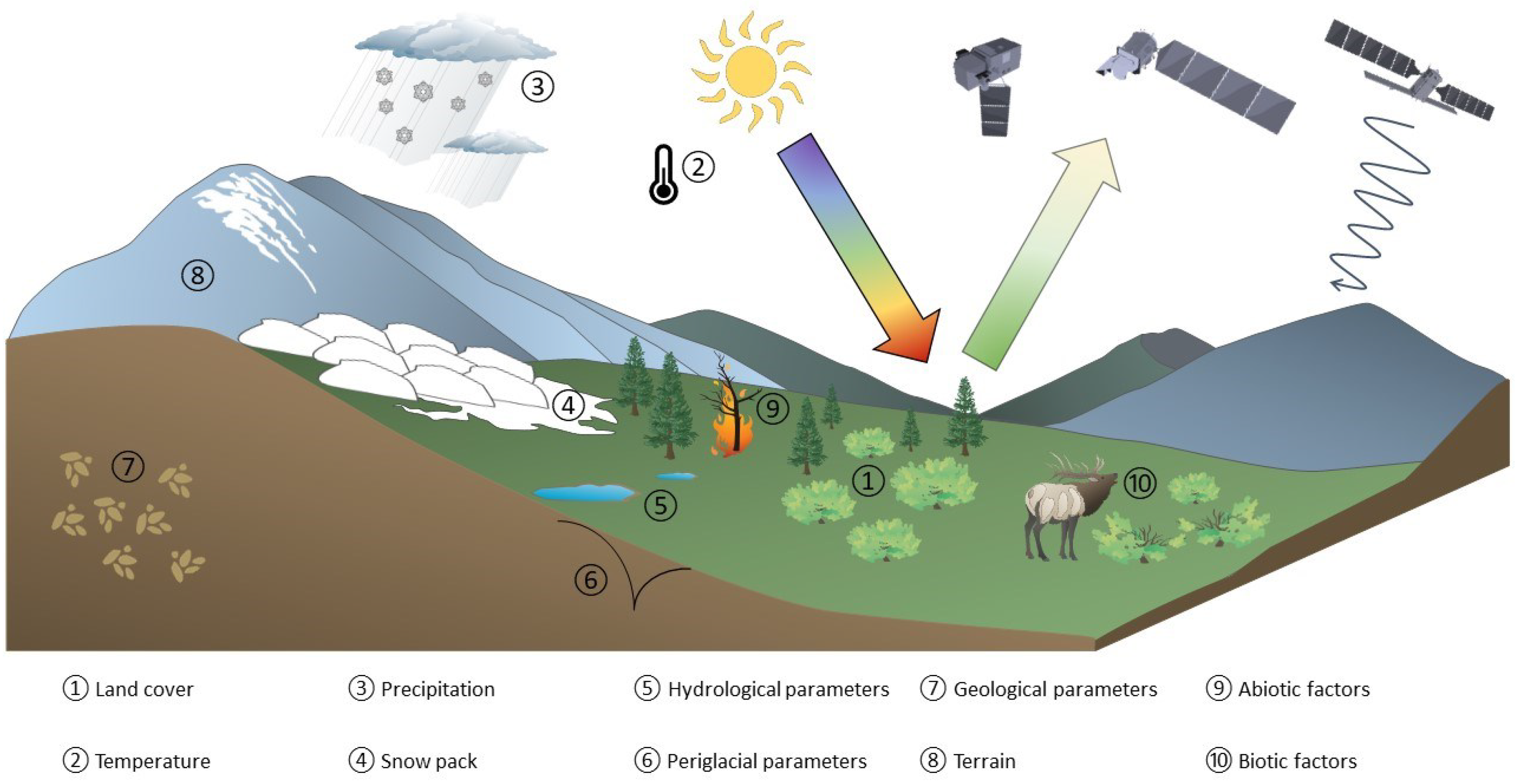
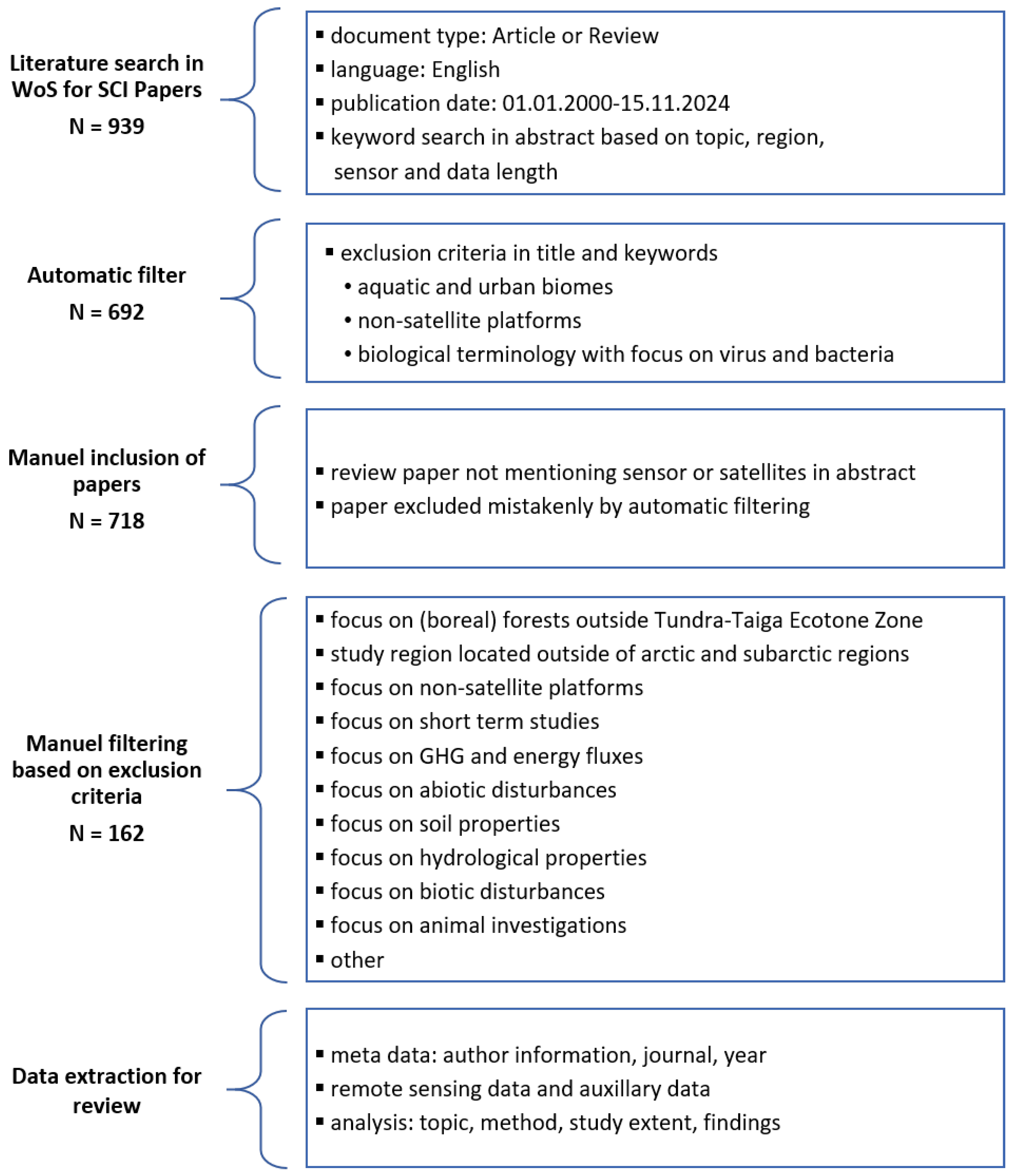


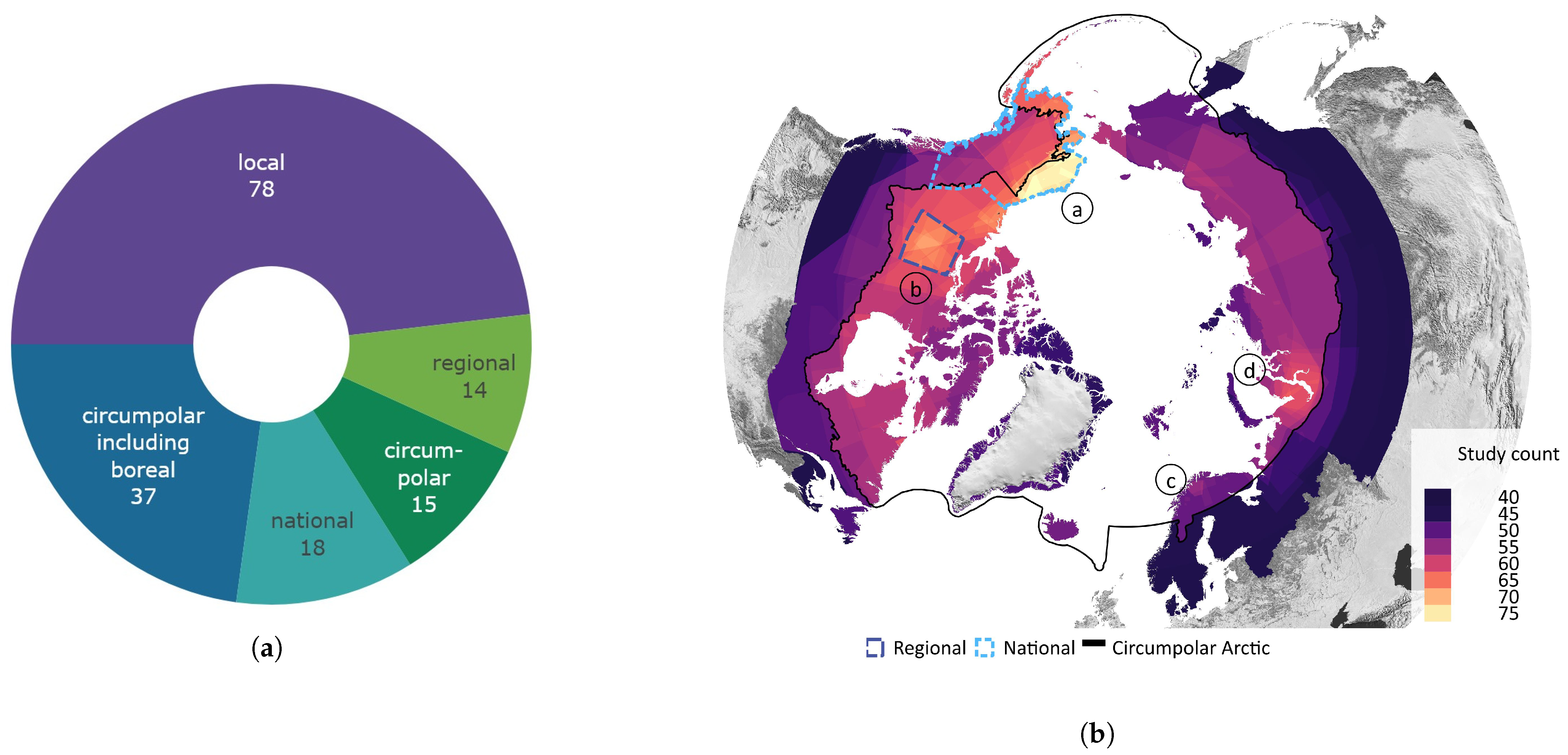
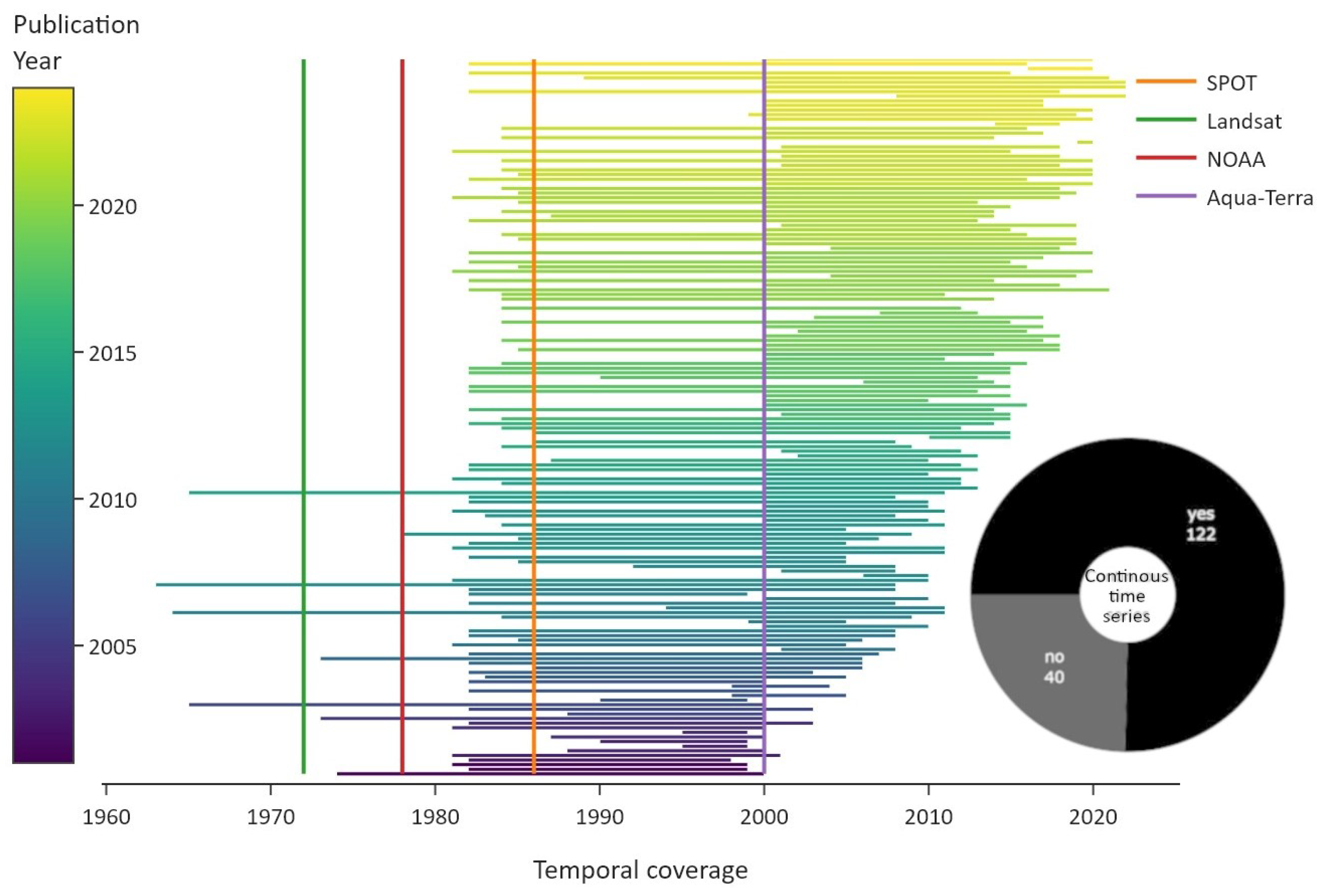

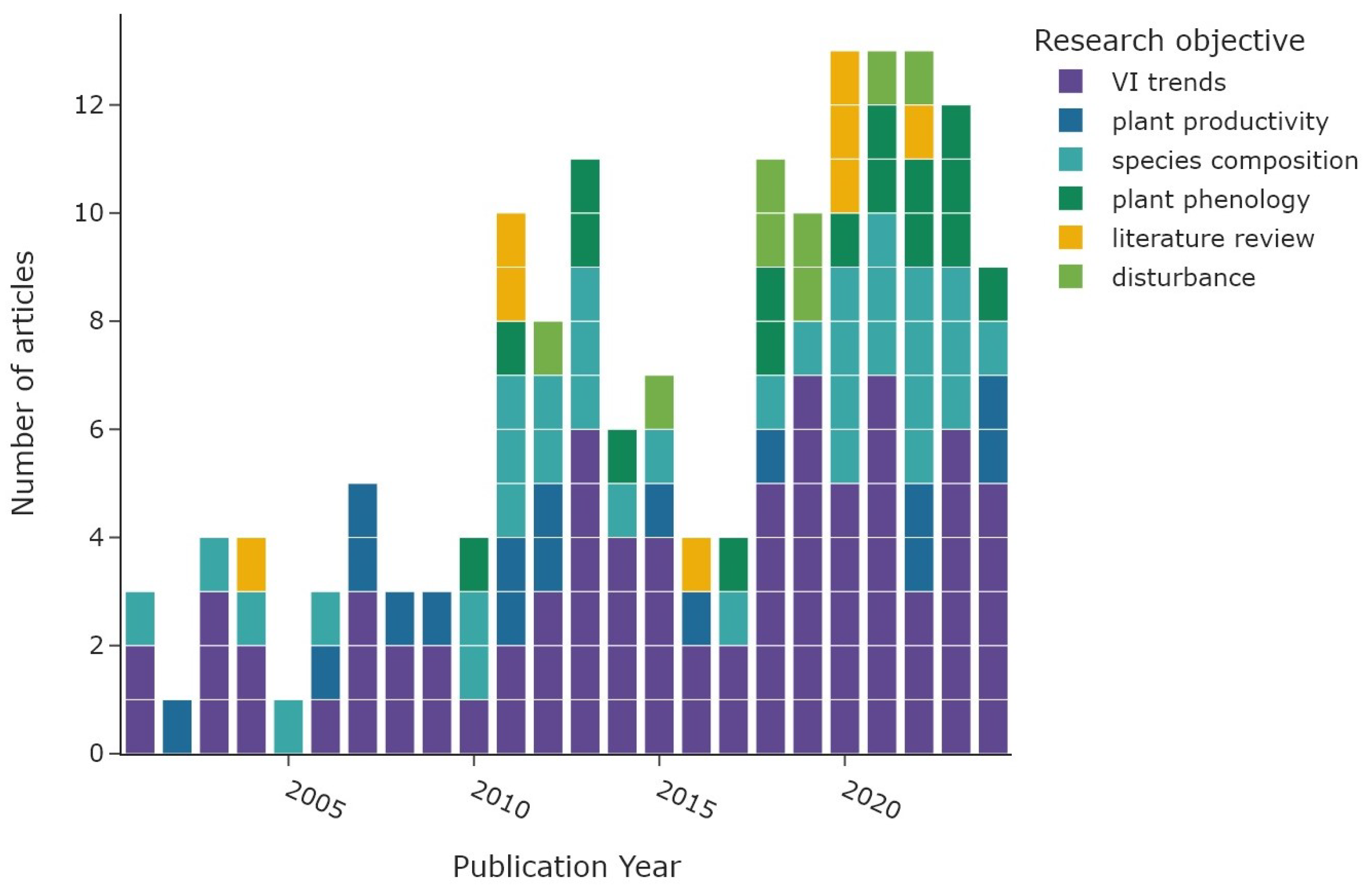
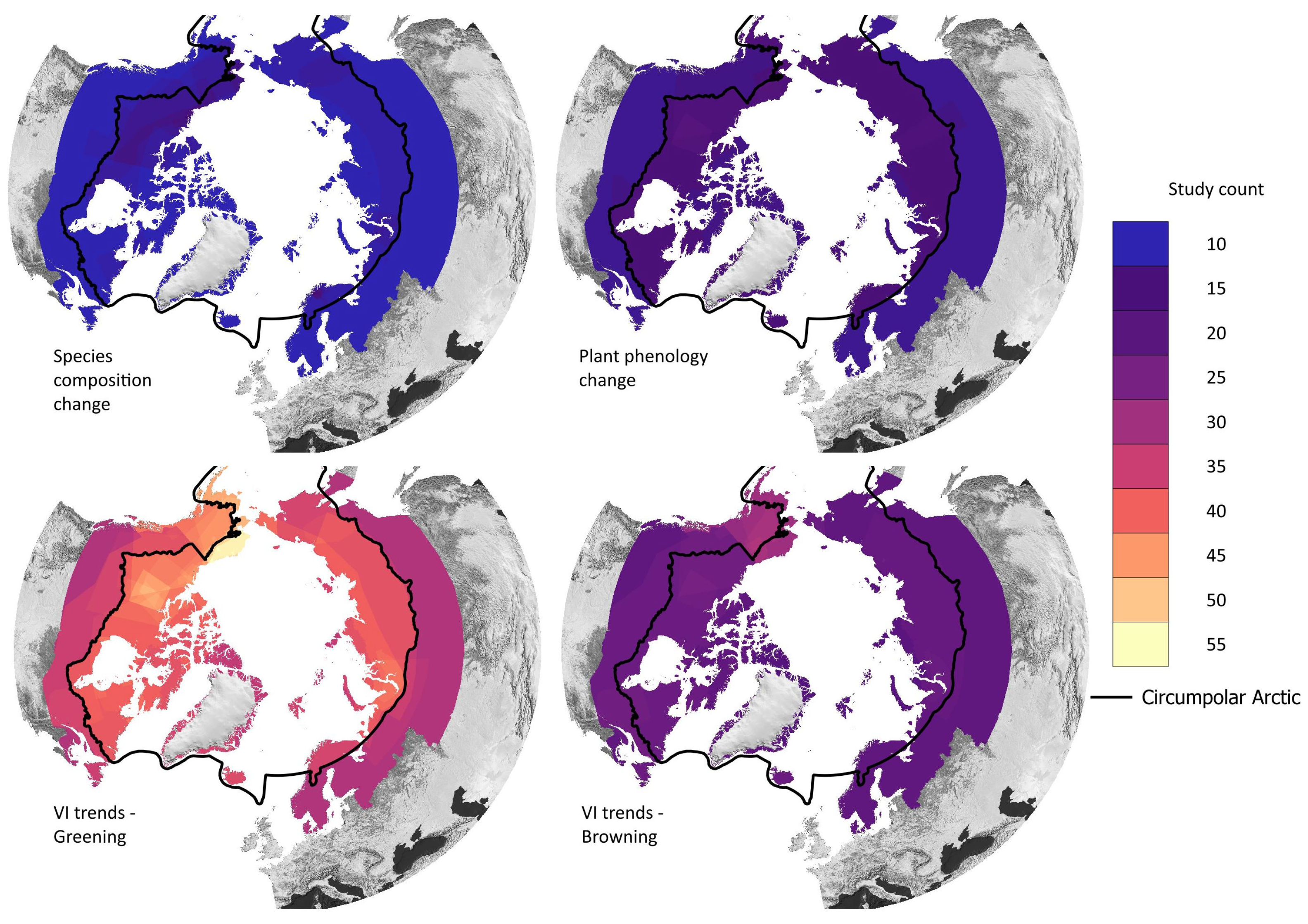
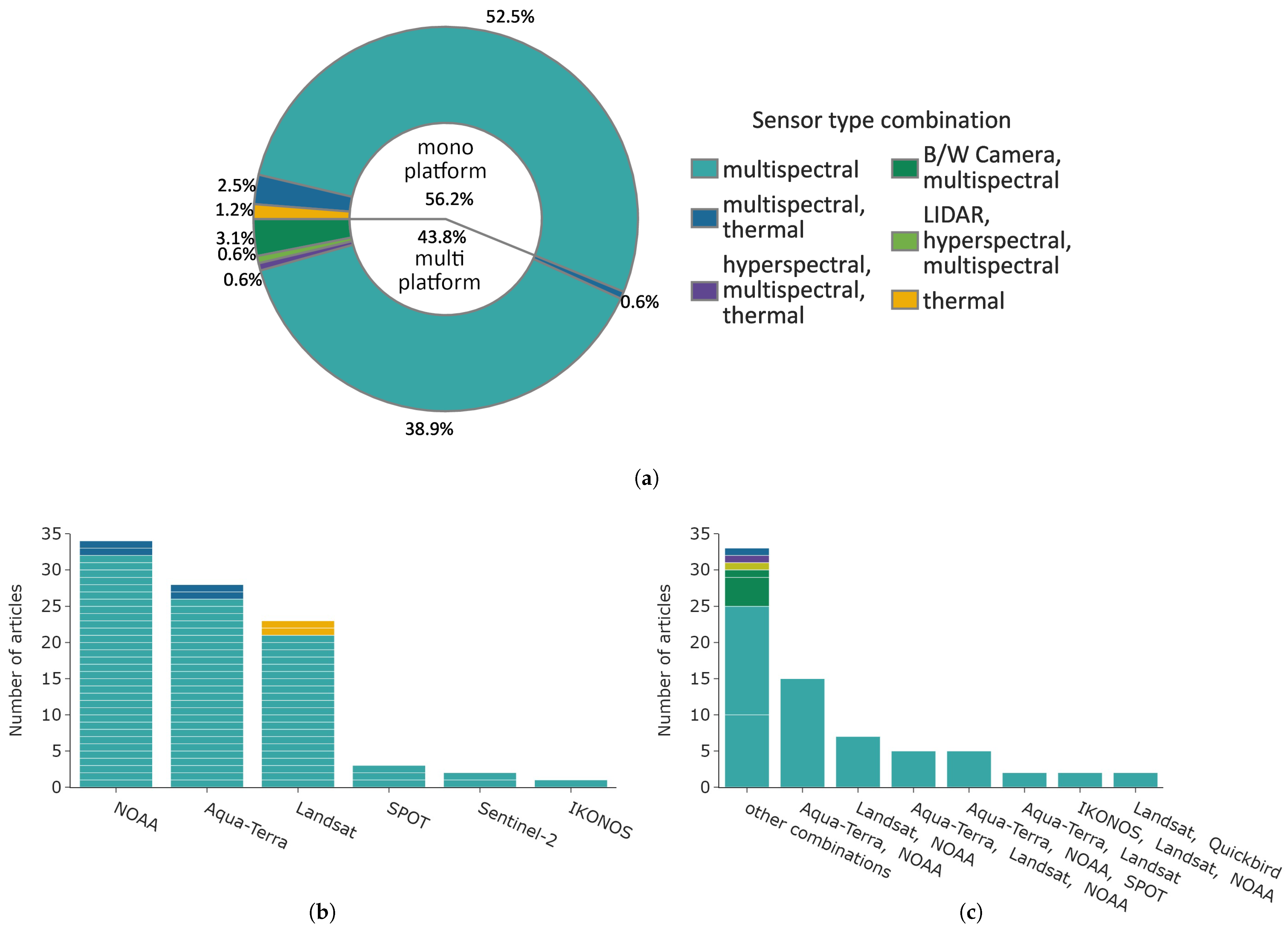
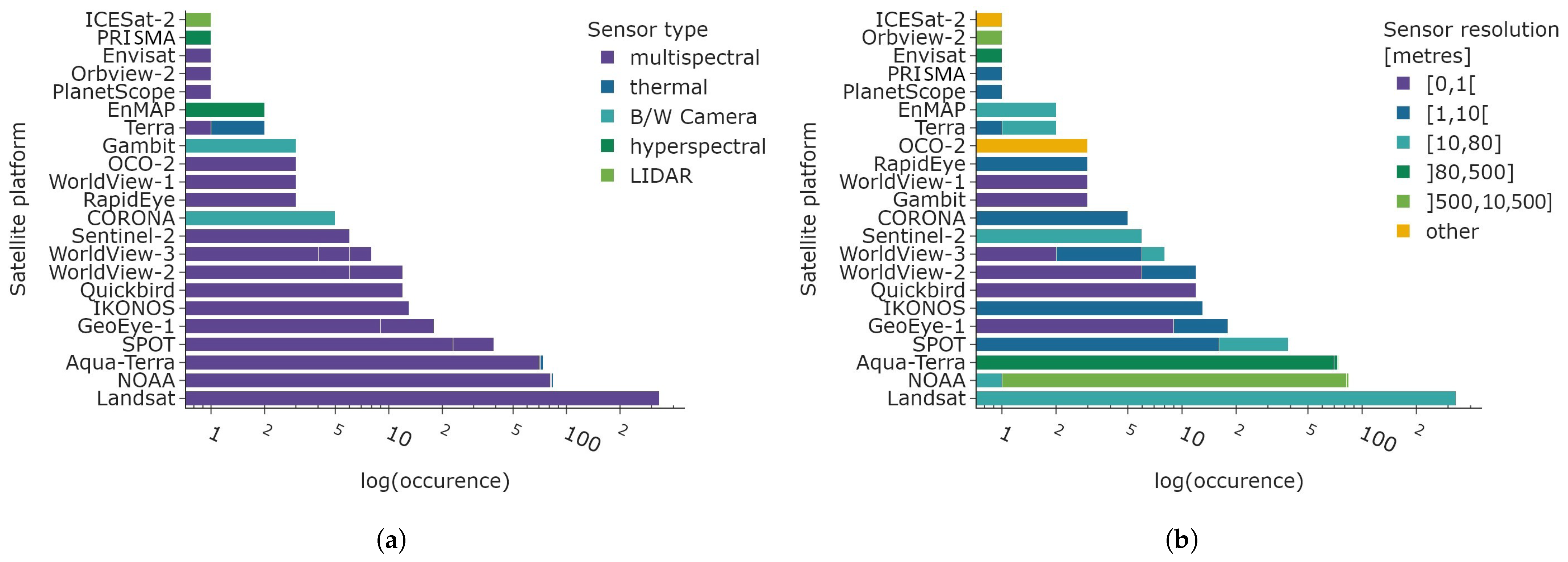
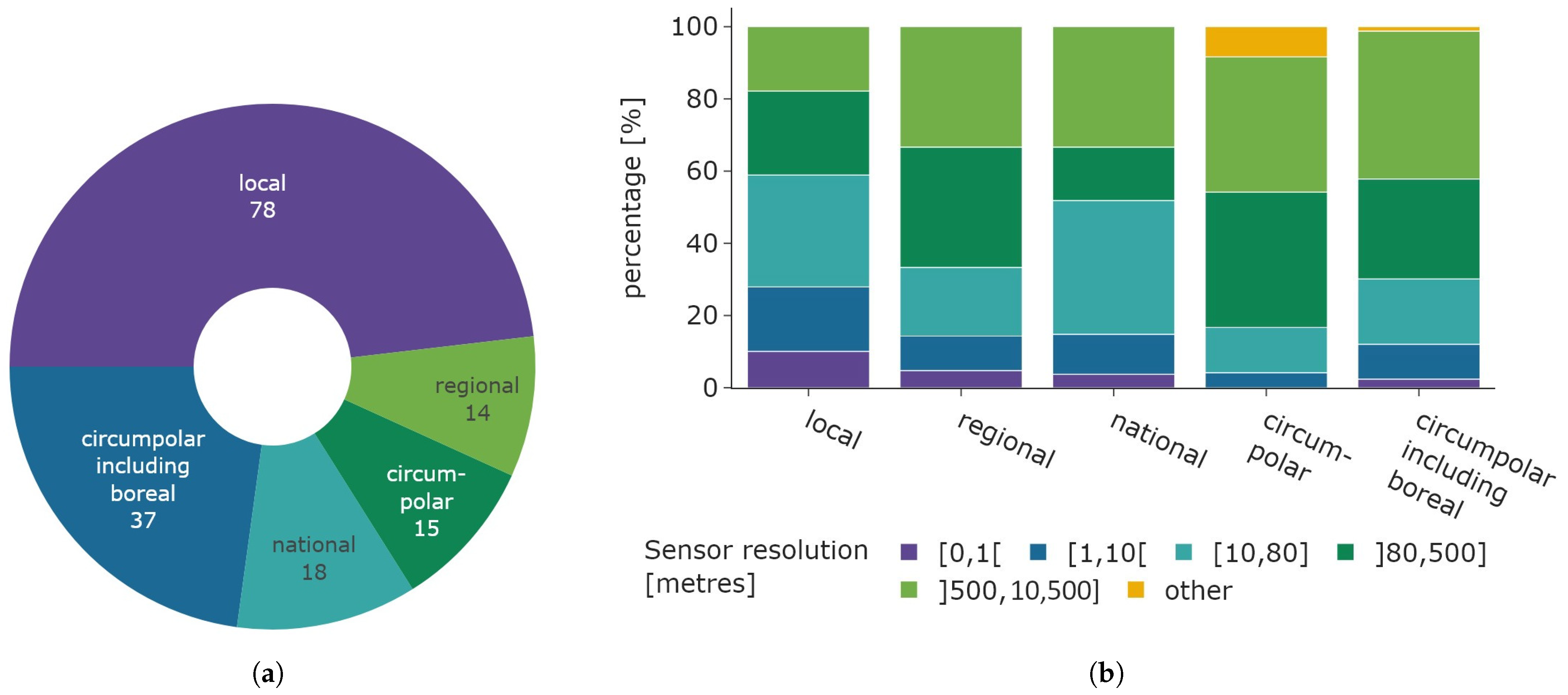

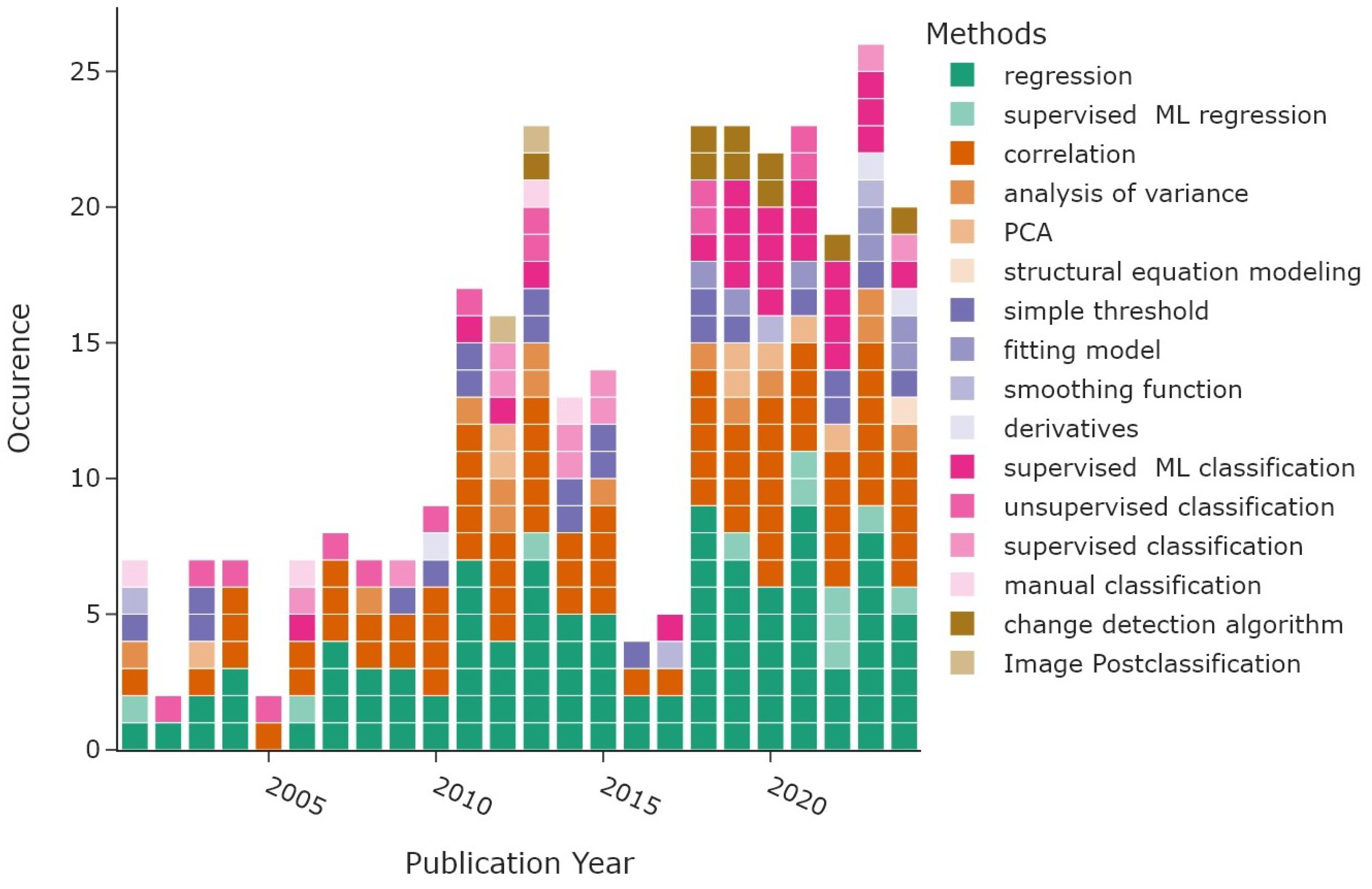
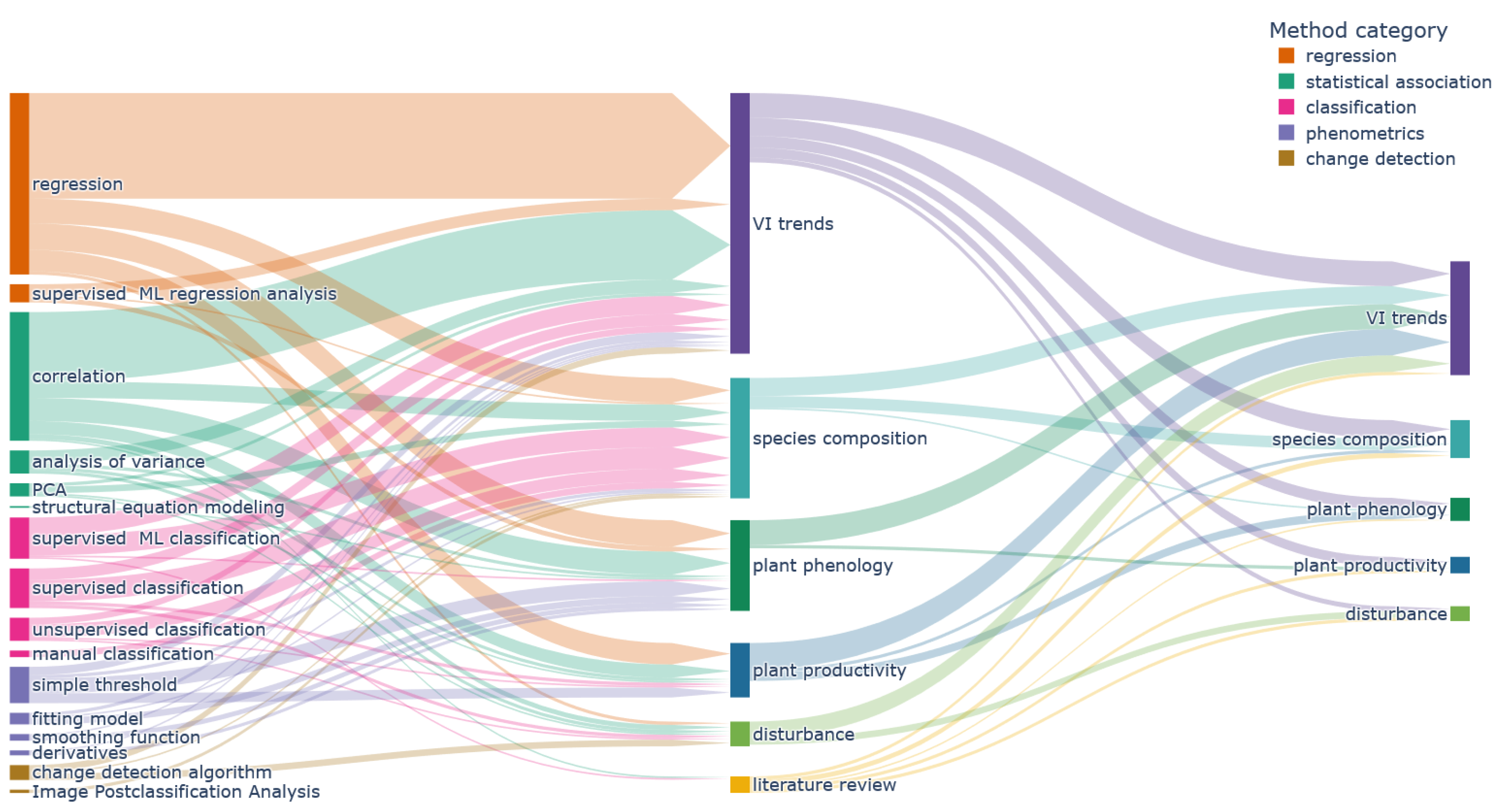
| Criteria | Conditions for Search in the Abstract Section |
|---|---|
| Vegetation | greening OR browning OR vegetation OR plant * OR grass OR forb OR sedge OR lichen OR shrub OR moss OR liverwort OR bryophytes OR cryptogam OR sphagnum OR mire OR fen OR bog |
| Study Region | arctic OR tundra OR circum polar OR pan arctic OR “TTE” OR “tundra-taiga ecotone” OR “taiga-tundra ecotone” OR “North* Canad*” OR Yukon OR Nunavut OR “Northwest Territories” OR Alberta OR Saskatchewan OR Manitoba OR Ontario OR Quebec OR “Newfoundland and Labrador” OR Greenland OR “North* Finland” OR Lapland OR Norrboten OR Iceland OR Austurland OR Westfjords OR Reykjavik OR “North* Norw*” OR Svalbard OR Nordland OR Troms OR Finnmark OR “North* Russia*” OR Siberia OR Murmansk OR Nenets Autnonoumous Okrug OR Komi Republic OR Yamalo-Nenets Autonomous Okrug OR Krasnoyarsk Krai OR Sakha Republic OR Magadan OR Chukotka Autonomous Okrug OR Kamchatka Krai OR Arkhangelsk OR “North* Swed*” OR Norrboten OR Västerboten OR Lapland OR Nord-Trondelag OR Alaska |
| Temporal Coverage | time series OR dynamic OR expansion OR extension OR reduction OR decline OR trend OR ((change OR variability OR seasonal *) AND multi temporal) |
| Sensors and Satellites | “remote sensing” OR “earth observation” OR “EO” OR “satellite” OR “spaceborne” OR multispectral OR optic* OR radar OR SAR OR Copernicus OR Sentinel-* OR Terra OR Aqua OR Envisat OR SPOT OR MSI OR ASTER OR Radarsat OR ASAR OR ETM* OR OLI* OR TIRS* OR MODIS OR MERIS OR OLCI OR AVHRR |
| Exclusion: Title and Keywords | ocean OR marine OR sea OR aquatic OR river OR lake OR ice OR drones OR UAV OR virus OR bacteria OR “sentinel species” OR “arctic oscillation” OR urban OR solifluction |
| Article Properties | Article OR Review AND LA=(English) AND DOP=(1 January 2000/15 November 2024) |
| Abbreviation | Radiometric Index | Spectral Range |
|---|---|---|
| NDVI | Normalised Difference Vegetation Index | Combination of red and near-infrared bands to create an index between [−1;1] indication water for negative values, barren soils for values around 0 and vegetation for values above 0.2 [84]. |
| EVI | Enhanced Vegetation Index | Combination of red, near-infrared and blue bands with adjustment factors for canopy background and aerosols to create an index between [−1;1] indicating vegetation vigour for values above 0.2 [84]. |
| LAI | Leaf Area Index | Dimensionless index for the one-sided green leaf area over a unit of land [84] based on non-linear relationships between VIs and LAI, generally derived by regional correlation study. |
| TCT | Tasseled Cap Transformation brightness, greenness, and wetness | Combination of blue (earlier products), green, red, near-infrared, thermal (recent products), and shortwave infrared bands to derive features [85]. |
| SIF | Solar Induced Chlorophyll Fluorescence | 2-peak spectrum around 650–850 nm spectral range as indicator for photosynthetic activity [86]. |
| NDWI | Normalized Difference Water Index | Combination of green and near-infrared bands to create an index between [−1;1] indicating water occurrence with values around 0.5, vegetation with smaller values, and built-up areas corresponding to values between zero and 0.2. NDWI and NDMI are often used synonymously [84]. |
| NDMI | Normalized Difference Moisture Index | Combination of near-infrared and shortwave infrared bands to create an index between [−1;1] indicating vegetation water content. NDWI and NDMI are often used synonymously. [84]. |
| FPAR/FAPAR | Fraction of Absorbed Photosynthetically Active Radiation | Fraction of incoming solar radiation that is absorbed by live vegetation [84]. |
| NDII | Normalized difference 819/1600 | Combination of wavelengths 819 nm and 1600 nm (e.g., bands B08, B11 in Sentinel-2) to create an index between [−1;1] indicating reflectance, depending on water content in plant canopies. Healthy vegetation generally ranges from 0.2 to 0.6 [84]. |
| SAVI | Soil Adjusted Vegetation Index | Combination of red, near-infrared bands and soil adjustment factor, with values depending on soil colour, soil moisture, and vegetation density [84]. |
| SR/RVI | Simple Ratio/Ratio Vegetation Index | Combination of red and near-infrared bands to indicate vegetation for high values by reducing topography and atmospheric effects [87]. |
| NDII7/NBR | Normalized Difference Infrared Index band 7/Normalized Burn Ratio | Combination of near-infrared and shortwave infrared bands to create an index between [−1;1] detecting burned areas [84]. |
| albedo | albedo | Fraction of reflected irradiance computed for the visible, near-infrared, and entire spectrum by integrating the Bidirectional Reflectance Distribution Function (BRDF) over the viewing hemisphere [88]. |
| Study Location | Greening Trend [1/yr] | Browning Trend [1/yr] | Greening [%] | Browning [%] | Trend Test and Significance Level | Article |
|---|---|---|---|---|---|---|
 | 0.00173 [1982–1999 AVHRR-NDVI] | p = 0.05; Kruskal–Wallis test; Levene’s test | [96] | |||
 | 0.002 [1982–1991 AVHRR-NDVI] | p = 0.02; two-tailed t-test; | [120] | |||
 | 0.003 [2000–2020 Landsat-NDVI] | −0.002 [2000–2015 AVHRR-NDVI] | p = 0.05; test not specified; | 19% of pixels | 1% of pixels | [107] |
 | 0.14 [2000–2017 MODIS-NDVI] | p = 0.001; two-tailed t-test; | [104] | |||
 | 0.01 [1982–2008 AVHRR-maxNDVI] | p = 0.05; two-tailed t-test; | [105] | |||
 | 0.003 [1984–2012 Landsat-NDVI] | −0.004 [1984–2012 Landsat-NDVI] | p = 0.01; Student’s t-test; | 30% of pixels | 3% of pixels | [55] |
 | 0.0025 [1984–2012 Landsat-NDVI] | −0.02 [1984–2012 Landsat-NDVI] | p = 0.05; test not specified. | 20–50% of pixels | 5–15% of pixels | [109] |
 | 0.002 [1984–2018 Landsat-NDVI] | p = 0.05; Theil–Sen slope; Student’s t-test; | 30% of pixels | [118] | ||
 | 0.002 [1984–2015 Landsat-NDVI] | −0.001/yr [1984–2015 Landsat-NDVI]; | p = 0.0001; Student’s t-tests. | [24] | ||
 | 0.003 [1982–2003 AVHRR-NDVI] | −0.003 [1982–2003 AVHRR-NDVI] | p = 0.01; test not specified; | [59] | ||
 | 0.0034 [1981–2011 AVHRR-NDVI] | −0.0047 [1981–2011 AVHRR-NDVI] | p = 0.05; Mann–Kendall test. | [94] | ||
 | 0.0016 [1984–2016 Landsat-EVI] | p = 0.05; Mann–Kendall test; Theil–Sen slope; | 68% of pixels | [101] |
Disclaimer/Publisher’s Note: The statements, opinions and data contained in all publications are solely those of the individual author(s) and contributor(s) and not of MDPI and/or the editor(s). MDPI and/or the editor(s) disclaim responsibility for any injury to people or property resulting from any ideas, methods, instructions or products referred to in the content. |
© 2024 by the authors. Licensee MDPI, Basel, Switzerland. This article is an open access article distributed under the terms and conditions of the Creative Commons Attribution (CC BY) license (https://creativecommons.org/licenses/by/4.0/).
Share and Cite
Wenzl, M.; Baumhoer, C.A.; Dietz, A.J.; Kuenzer, C. Vegetation Changes in the Arctic: A Review of Earth Observation Applications. Remote Sens. 2024, 16, 4509. https://doi.org/10.3390/rs16234509
Wenzl M, Baumhoer CA, Dietz AJ, Kuenzer C. Vegetation Changes in the Arctic: A Review of Earth Observation Applications. Remote Sensing. 2024; 16(23):4509. https://doi.org/10.3390/rs16234509
Chicago/Turabian StyleWenzl, Martina, Celia A. Baumhoer, Andreas J. Dietz, and Claudia Kuenzer. 2024. "Vegetation Changes in the Arctic: A Review of Earth Observation Applications" Remote Sensing 16, no. 23: 4509. https://doi.org/10.3390/rs16234509
APA StyleWenzl, M., Baumhoer, C. A., Dietz, A. J., & Kuenzer, C. (2024). Vegetation Changes in the Arctic: A Review of Earth Observation Applications. Remote Sensing, 16(23), 4509. https://doi.org/10.3390/rs16234509






